Review and Critique of Operations Management at Unilever PLC
VerifiedAdded on 2023/06/07
|22
|5211
|270
AI Summary
This report provides an analysis of the operations management principles implemented at Unilever PLC. It includes an explanation of operation vs operations management, a review and critique of the implementation of operations management principles, an analysis of the extent to which the operations management of the organization meets the requirements of the organization, and a discussion of continuous improvement as a philosophy and describes the Lean principles including Six Sigma. The report also includes a continuous improvement plan based on the review and critique of operations management principles within Unilever PLC.
Contribute Materials
Your contribution can guide someone’s learning journey. Share your
documents today.
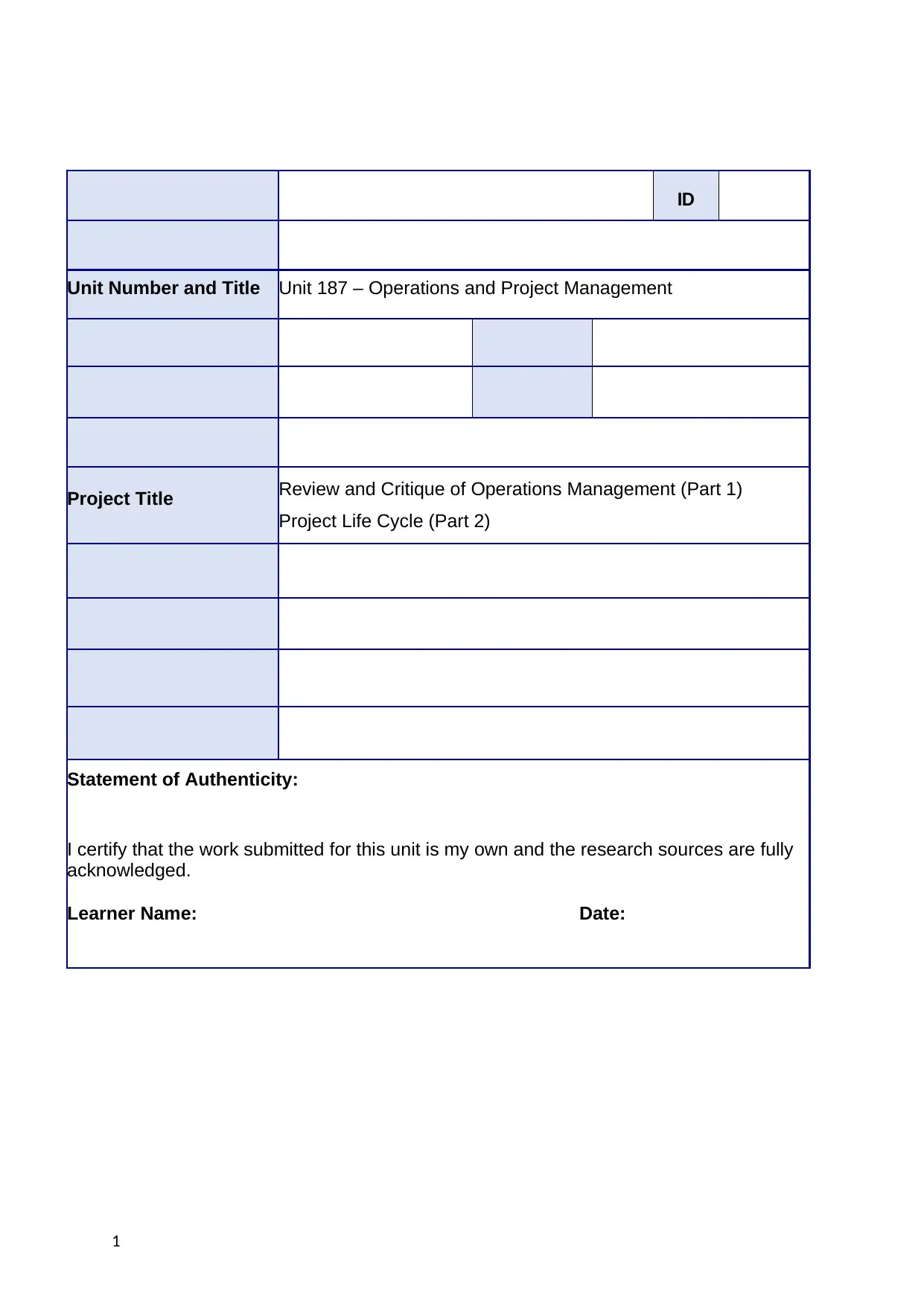
ID
Unit Number and Title Unit 187 – Operations and Project Management
Project Title Review and Critique of Operations Management (Part 1)
Project Life Cycle (Part 2)
Statement of Authenticity:
I certify that the work submitted for this unit is my own and the research sources are fully
acknowledged.
Learner Name: Date:
1
Unit Number and Title Unit 187 – Operations and Project Management
Project Title Review and Critique of Operations Management (Part 1)
Project Life Cycle (Part 2)
Statement of Authenticity:
I certify that the work submitted for this unit is my own and the research sources are fully
acknowledged.
Learner Name: Date:
1
Secure Best Marks with AI Grader
Need help grading? Try our AI Grader for instant feedback on your assignments.
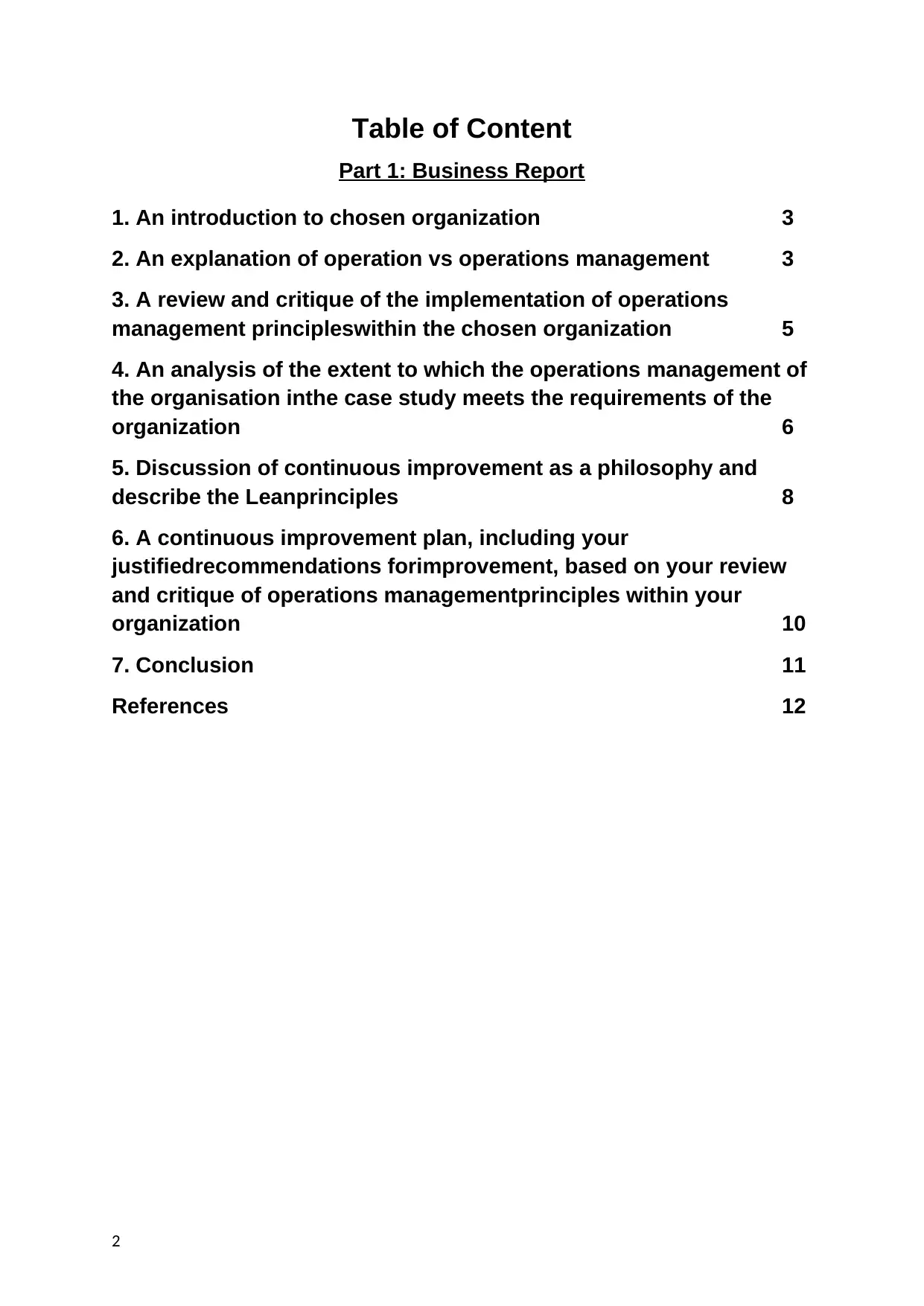
Table of Content
Part 1: Business Report
1. An introduction to chosen organization 3
2. An explanation of operation vs operations management 3
3. A review and critique of the implementation of operations
management principleswithin the chosen organization 5
4. An analysis of the extent to which the operations management of
the organisation inthe case study meets the requirements of the
organization 6
5. Discussion of continuous improvement as a philosophy and
describe the Leanprinciples 8
6. A continuous improvement plan, including your
justifiedrecommendations forimprovement, based on your review
and critique of operations managementprinciples within your
organization 10
7. Conclusion 11
References 12
2
Part 1: Business Report
1. An introduction to chosen organization 3
2. An explanation of operation vs operations management 3
3. A review and critique of the implementation of operations
management principleswithin the chosen organization 5
4. An analysis of the extent to which the operations management of
the organisation inthe case study meets the requirements of the
organization 6
5. Discussion of continuous improvement as a philosophy and
describe the Leanprinciples 8
6. A continuous improvement plan, including your
justifiedrecommendations forimprovement, based on your review
and critique of operations managementprinciples within your
organization 10
7. Conclusion 11
References 12
2
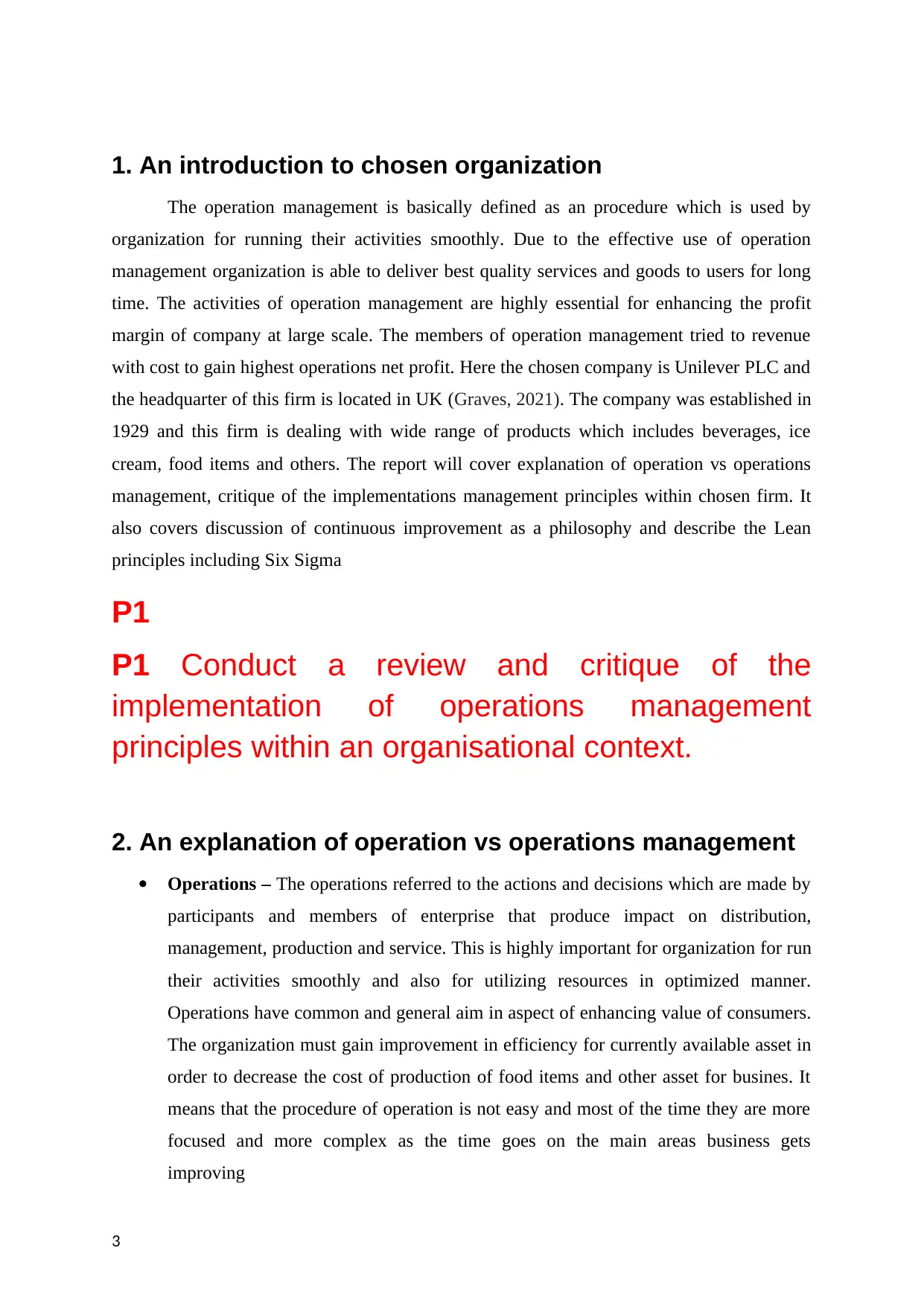
1. An introduction to chosen organization
The operation management is basically defined as an procedure which is used by
organization for running their activities smoothly. Due to the effective use of operation
management organization is able to deliver best quality services and goods to users for long
time. The activities of operation management are highly essential for enhancing the profit
margin of company at large scale. The members of operation management tried to revenue
with cost to gain highest operations net profit. Here the chosen company is Unilever PLC and
the headquarter of this firm is located in UK (Graves, 2021). The company was established in
1929 and this firm is dealing with wide range of products which includes beverages, ice
cream, food items and others. The report will cover explanation of operation vs operations
management, critique of the implementations management principles within chosen firm. It
also covers discussion of continuous improvement as a philosophy and describe the Lean
principles including Six Sigma
P1
P1 Conduct a review and critique of the
implementation of operations management
principles within an organisational context.
2. An explanation of operation vs operations management
Operations – The operations referred to the actions and decisions which are made by
participants and members of enterprise that produce impact on distribution,
management, production and service. This is highly important for organization for run
their activities smoothly and also for utilizing resources in optimized manner.
Operations have common and general aim in aspect of enhancing value of consumers.
The organization must gain improvement in efficiency for currently available asset in
order to decrease the cost of production of food items and other asset for busines. It
means that the procedure of operation is not easy and most of the time they are more
focused and more complex as the time goes on the main areas business gets
improving
3
The operation management is basically defined as an procedure which is used by
organization for running their activities smoothly. Due to the effective use of operation
management organization is able to deliver best quality services and goods to users for long
time. The activities of operation management are highly essential for enhancing the profit
margin of company at large scale. The members of operation management tried to revenue
with cost to gain highest operations net profit. Here the chosen company is Unilever PLC and
the headquarter of this firm is located in UK (Graves, 2021). The company was established in
1929 and this firm is dealing with wide range of products which includes beverages, ice
cream, food items and others. The report will cover explanation of operation vs operations
management, critique of the implementations management principles within chosen firm. It
also covers discussion of continuous improvement as a philosophy and describe the Lean
principles including Six Sigma
P1
P1 Conduct a review and critique of the
implementation of operations management
principles within an organisational context.
2. An explanation of operation vs operations management
Operations – The operations referred to the actions and decisions which are made by
participants and members of enterprise that produce impact on distribution,
management, production and service. This is highly important for organization for run
their activities smoothly and also for utilizing resources in optimized manner.
Operations have common and general aim in aspect of enhancing value of consumers.
The organization must gain improvement in efficiency for currently available asset in
order to decrease the cost of production of food items and other asset for busines. It
means that the procedure of operation is not easy and most of the time they are more
focused and more complex as the time goes on the main areas business gets
improving
3
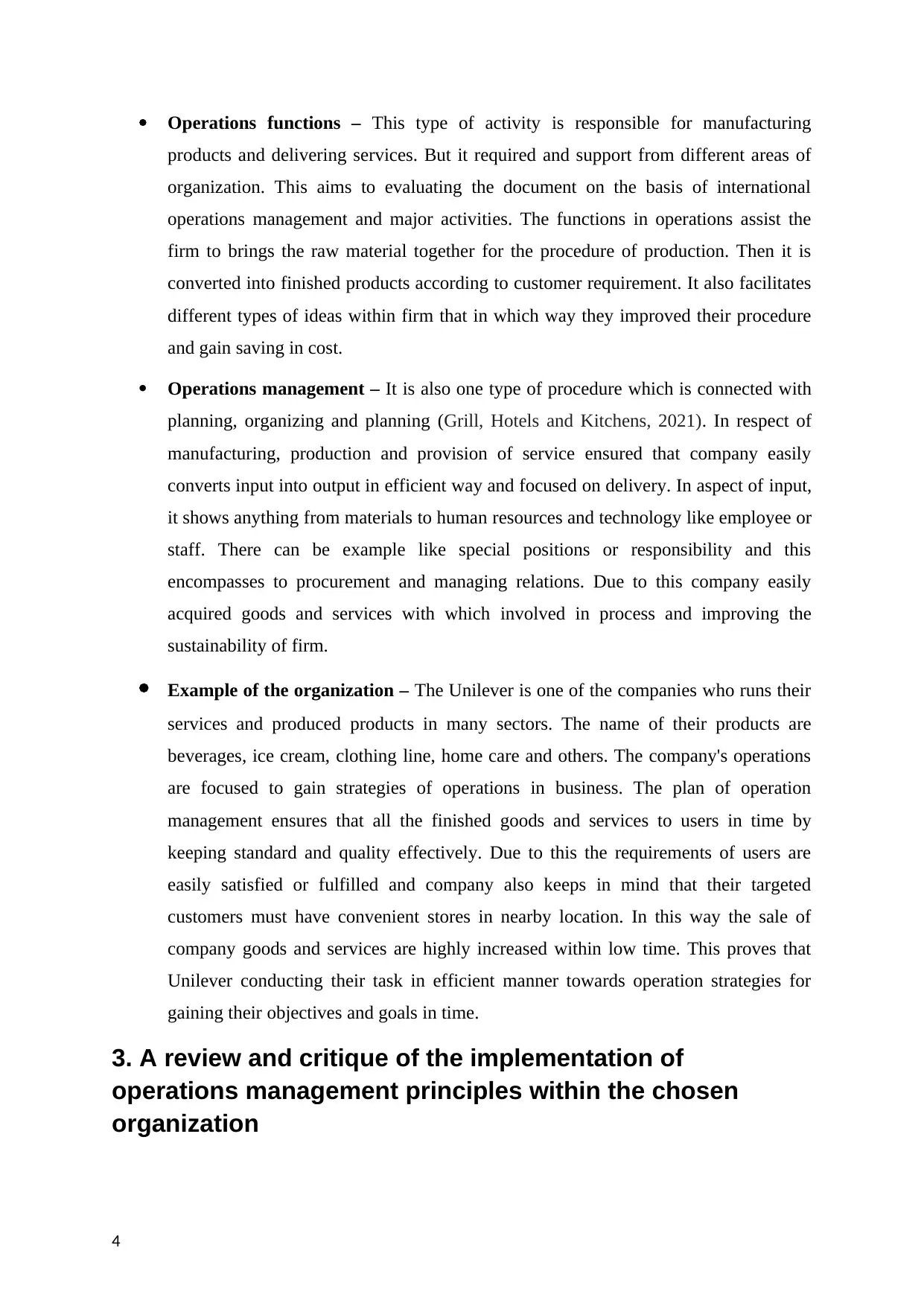
Operations functions – This type of activity is responsible for manufacturing
products and delivering services. But it required and support from different areas of
organization. This aims to evaluating the document on the basis of international
operations management and major activities. The functions in operations assist the
firm to brings the raw material together for the procedure of production. Then it is
converted into finished products according to customer requirement. It also facilitates
different types of ideas within firm that in which way they improved their procedure
and gain saving in cost.
Operations management – It is also one type of procedure which is connected with
planning, organizing and planning (Grill, Hotels and Kitchens, 2021). In respect of
manufacturing, production and provision of service ensured that company easily
converts input into output in efficient way and focused on delivery. In aspect of input,
it shows anything from materials to human resources and technology like employee or
staff. There can be example like special positions or responsibility and this
encompasses to procurement and managing relations. Due to this company easily
acquired goods and services with which involved in process and improving the
sustainability of firm.
Example of the organization – The Unilever is one of the companies who runs their
services and produced products in many sectors. The name of their products are
beverages, ice cream, clothing line, home care and others. The company's operations
are focused to gain strategies of operations in business. The plan of operation
management ensures that all the finished goods and services to users in time by
keeping standard and quality effectively. Due to this the requirements of users are
easily satisfied or fulfilled and company also keeps in mind that their targeted
customers must have convenient stores in nearby location. In this way the sale of
company goods and services are highly increased within low time. This proves that
Unilever conducting their task in efficient manner towards operation strategies for
gaining their objectives and goals in time.
3. A review and critique of the implementation of
operations management principles within the chosen
organization
4
products and delivering services. But it required and support from different areas of
organization. This aims to evaluating the document on the basis of international
operations management and major activities. The functions in operations assist the
firm to brings the raw material together for the procedure of production. Then it is
converted into finished products according to customer requirement. It also facilitates
different types of ideas within firm that in which way they improved their procedure
and gain saving in cost.
Operations management – It is also one type of procedure which is connected with
planning, organizing and planning (Grill, Hotels and Kitchens, 2021). In respect of
manufacturing, production and provision of service ensured that company easily
converts input into output in efficient way and focused on delivery. In aspect of input,
it shows anything from materials to human resources and technology like employee or
staff. There can be example like special positions or responsibility and this
encompasses to procurement and managing relations. Due to this company easily
acquired goods and services with which involved in process and improving the
sustainability of firm.
Example of the organization – The Unilever is one of the companies who runs their
services and produced products in many sectors. The name of their products are
beverages, ice cream, clothing line, home care and others. The company's operations
are focused to gain strategies of operations in business. The plan of operation
management ensures that all the finished goods and services to users in time by
keeping standard and quality effectively. Due to this the requirements of users are
easily satisfied or fulfilled and company also keeps in mind that their targeted
customers must have convenient stores in nearby location. In this way the sale of
company goods and services are highly increased within low time. This proves that
Unilever conducting their task in efficient manner towards operation strategies for
gaining their objectives and goals in time.
3. A review and critique of the implementation of
operations management principles within the chosen
organization
4
Secure Best Marks with AI Grader
Need help grading? Try our AI Grader for instant feedback on your assignments.
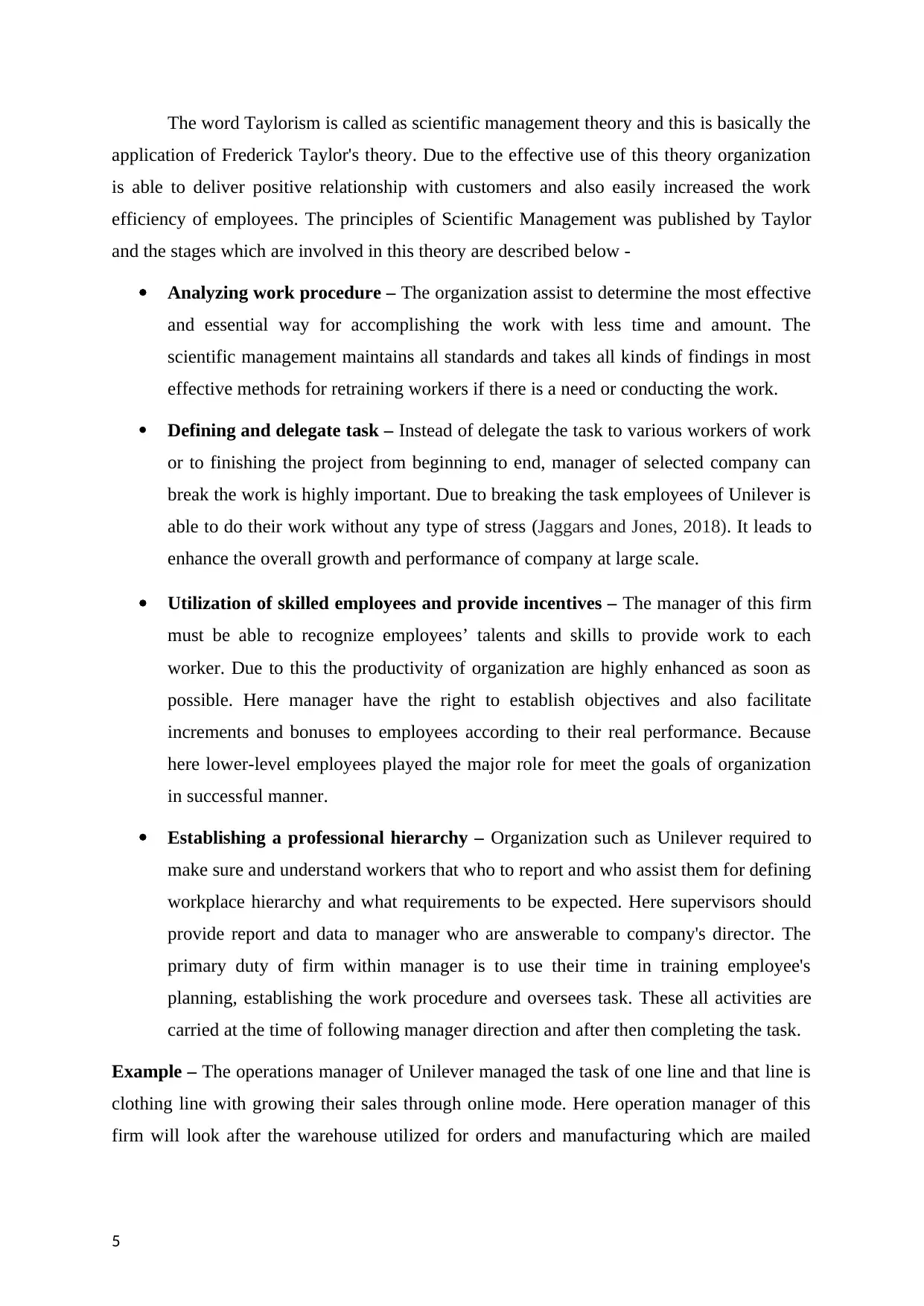
The word Taylorism is called as scientific management theory and this is basically the
application of Frederick Taylor's theory. Due to the effective use of this theory organization
is able to deliver positive relationship with customers and also easily increased the work
efficiency of employees. The principles of Scientific Management was published by Taylor
and the stages which are involved in this theory are described below -
Analyzing work procedure – The organization assist to determine the most effective
and essential way for accomplishing the work with less time and amount. The
scientific management maintains all standards and takes all kinds of findings in most
effective methods for retraining workers if there is a need or conducting the work.
Defining and delegate task – Instead of delegate the task to various workers of work
or to finishing the project from beginning to end, manager of selected company can
break the work is highly important. Due to breaking the task employees of Unilever is
able to do their work without any type of stress (Jaggars and Jones, 2018). It leads to
enhance the overall growth and performance of company at large scale.
Utilization of skilled employees and provide incentives – The manager of this firm
must be able to recognize employees’ talents and skills to provide work to each
worker. Due to this the productivity of organization are highly enhanced as soon as
possible. Here manager have the right to establish objectives and also facilitate
increments and bonuses to employees according to their real performance. Because
here lower-level employees played the major role for meet the goals of organization
in successful manner.
Establishing a professional hierarchy – Organization such as Unilever required to
make sure and understand workers that who to report and who assist them for defining
workplace hierarchy and what requirements to be expected. Here supervisors should
provide report and data to manager who are answerable to company's director. The
primary duty of firm within manager is to use their time in training employee's
planning, establishing the work procedure and oversees task. These all activities are
carried at the time of following manager direction and after then completing the task.
Example – The operations manager of Unilever managed the task of one line and that line is
clothing line with growing their sales through online mode. Here operation manager of this
firm will look after the warehouse utilized for orders and manufacturing which are mailed
5
application of Frederick Taylor's theory. Due to the effective use of this theory organization
is able to deliver positive relationship with customers and also easily increased the work
efficiency of employees. The principles of Scientific Management was published by Taylor
and the stages which are involved in this theory are described below -
Analyzing work procedure – The organization assist to determine the most effective
and essential way for accomplishing the work with less time and amount. The
scientific management maintains all standards and takes all kinds of findings in most
effective methods for retraining workers if there is a need or conducting the work.
Defining and delegate task – Instead of delegate the task to various workers of work
or to finishing the project from beginning to end, manager of selected company can
break the work is highly important. Due to breaking the task employees of Unilever is
able to do their work without any type of stress (Jaggars and Jones, 2018). It leads to
enhance the overall growth and performance of company at large scale.
Utilization of skilled employees and provide incentives – The manager of this firm
must be able to recognize employees’ talents and skills to provide work to each
worker. Due to this the productivity of organization are highly enhanced as soon as
possible. Here manager have the right to establish objectives and also facilitate
increments and bonuses to employees according to their real performance. Because
here lower-level employees played the major role for meet the goals of organization
in successful manner.
Establishing a professional hierarchy – Organization such as Unilever required to
make sure and understand workers that who to report and who assist them for defining
workplace hierarchy and what requirements to be expected. Here supervisors should
provide report and data to manager who are answerable to company's director. The
primary duty of firm within manager is to use their time in training employee's
planning, establishing the work procedure and oversees task. These all activities are
carried at the time of following manager direction and after then completing the task.
Example – The operations manager of Unilever managed the task of one line and that line is
clothing line with growing their sales through online mode. Here operation manager of this
firm will look after the warehouse utilized for orders and manufacturing which are mailed
5
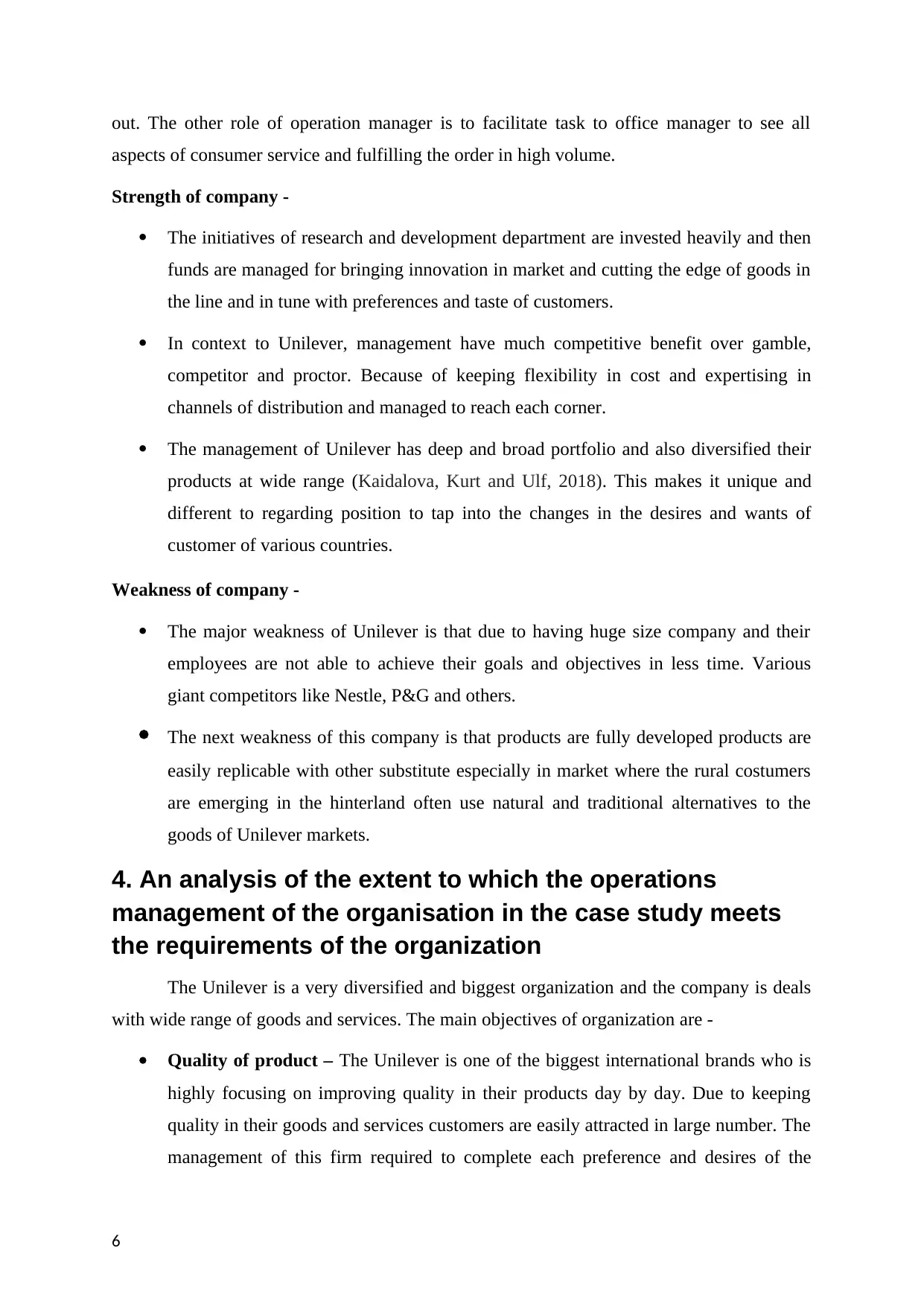
out. The other role of operation manager is to facilitate task to office manager to see all
aspects of consumer service and fulfilling the order in high volume.
Strength of company -
The initiatives of research and development department are invested heavily and then
funds are managed for bringing innovation in market and cutting the edge of goods in
the line and in tune with preferences and taste of customers.
In context to Unilever, management have much competitive benefit over gamble,
competitor and proctor. Because of keeping flexibility in cost and expertising in
channels of distribution and managed to reach each corner.
The management of Unilever has deep and broad portfolio and also diversified their
products at wide range (Kaidalova, Kurt and Ulf, 2018). This makes it unique and
different to regarding position to tap into the changes in the desires and wants of
customer of various countries.
Weakness of company -
The major weakness of Unilever is that due to having huge size company and their
employees are not able to achieve their goals and objectives in less time. Various
giant competitors like Nestle, P&G and others.
The next weakness of this company is that products are fully developed products are
easily replicable with other substitute especially in market where the rural costumers
are emerging in the hinterland often use natural and traditional alternatives to the
goods of Unilever markets.
4. An analysis of the extent to which the operations
management of the organisation in the case study meets
the requirements of the organization
The Unilever is a very diversified and biggest organization and the company is deals
with wide range of goods and services. The main objectives of organization are -
Quality of product – The Unilever is one of the biggest international brands who is
highly focusing on improving quality in their products day by day. Due to keeping
quality in their goods and services customers are easily attracted in large number. The
management of this firm required to complete each preference and desires of the
6
aspects of consumer service and fulfilling the order in high volume.
Strength of company -
The initiatives of research and development department are invested heavily and then
funds are managed for bringing innovation in market and cutting the edge of goods in
the line and in tune with preferences and taste of customers.
In context to Unilever, management have much competitive benefit over gamble,
competitor and proctor. Because of keeping flexibility in cost and expertising in
channels of distribution and managed to reach each corner.
The management of Unilever has deep and broad portfolio and also diversified their
products at wide range (Kaidalova, Kurt and Ulf, 2018). This makes it unique and
different to regarding position to tap into the changes in the desires and wants of
customer of various countries.
Weakness of company -
The major weakness of Unilever is that due to having huge size company and their
employees are not able to achieve their goals and objectives in less time. Various
giant competitors like Nestle, P&G and others.
The next weakness of this company is that products are fully developed products are
easily replicable with other substitute especially in market where the rural costumers
are emerging in the hinterland often use natural and traditional alternatives to the
goods of Unilever markets.
4. An analysis of the extent to which the operations
management of the organisation in the case study meets
the requirements of the organization
The Unilever is a very diversified and biggest organization and the company is deals
with wide range of goods and services. The main objectives of organization are -
Quality of product – The Unilever is one of the biggest international brands who is
highly focusing on improving quality in their products day by day. Due to keeping
quality in their goods and services customers are easily attracted in large number. The
management of this firm required to complete each preference and desires of the
6
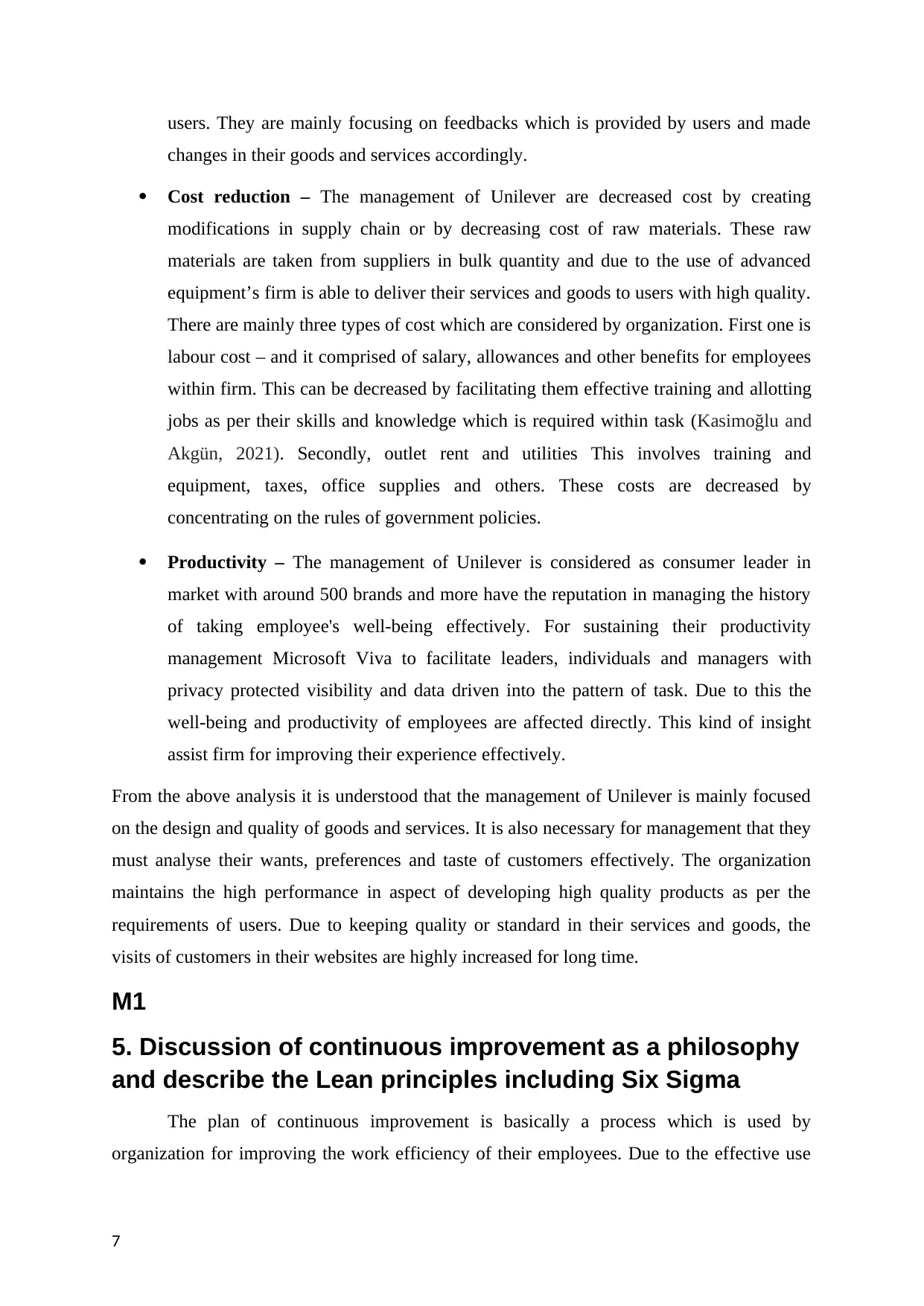
users. They are mainly focusing on feedbacks which is provided by users and made
changes in their goods and services accordingly.
Cost reduction – The management of Unilever are decreased cost by creating
modifications in supply chain or by decreasing cost of raw materials. These raw
materials are taken from suppliers in bulk quantity and due to the use of advanced
equipment’s firm is able to deliver their services and goods to users with high quality.
There are mainly three types of cost which are considered by organization. First one is
labour cost – and it comprised of salary, allowances and other benefits for employees
within firm. This can be decreased by facilitating them effective training and allotting
jobs as per their skills and knowledge which is required within task (Kasimoğlu and
Akgün, 2021). Secondly, outlet rent and utilities This involves training and
equipment, taxes, office supplies and others. These costs are decreased by
concentrating on the rules of government policies.
Productivity – The management of Unilever is considered as consumer leader in
market with around 500 brands and more have the reputation in managing the history
of taking employee's well-being effectively. For sustaining their productivity
management Microsoft Viva to facilitate leaders, individuals and managers with
privacy protected visibility and data driven into the pattern of task. Due to this the
well-being and productivity of employees are affected directly. This kind of insight
assist firm for improving their experience effectively.
From the above analysis it is understood that the management of Unilever is mainly focused
on the design and quality of goods and services. It is also necessary for management that they
must analyse their wants, preferences and taste of customers effectively. The organization
maintains the high performance in aspect of developing high quality products as per the
requirements of users. Due to keeping quality or standard in their services and goods, the
visits of customers in their websites are highly increased for long time.
M1
5. Discussion of continuous improvement as a philosophy
and describe the Lean principles including Six Sigma
The plan of continuous improvement is basically a process which is used by
organization for improving the work efficiency of their employees. Due to the effective use
7
changes in their goods and services accordingly.
Cost reduction – The management of Unilever are decreased cost by creating
modifications in supply chain or by decreasing cost of raw materials. These raw
materials are taken from suppliers in bulk quantity and due to the use of advanced
equipment’s firm is able to deliver their services and goods to users with high quality.
There are mainly three types of cost which are considered by organization. First one is
labour cost – and it comprised of salary, allowances and other benefits for employees
within firm. This can be decreased by facilitating them effective training and allotting
jobs as per their skills and knowledge which is required within task (Kasimoğlu and
Akgün, 2021). Secondly, outlet rent and utilities This involves training and
equipment, taxes, office supplies and others. These costs are decreased by
concentrating on the rules of government policies.
Productivity – The management of Unilever is considered as consumer leader in
market with around 500 brands and more have the reputation in managing the history
of taking employee's well-being effectively. For sustaining their productivity
management Microsoft Viva to facilitate leaders, individuals and managers with
privacy protected visibility and data driven into the pattern of task. Due to this the
well-being and productivity of employees are affected directly. This kind of insight
assist firm for improving their experience effectively.
From the above analysis it is understood that the management of Unilever is mainly focused
on the design and quality of goods and services. It is also necessary for management that they
must analyse their wants, preferences and taste of customers effectively. The organization
maintains the high performance in aspect of developing high quality products as per the
requirements of users. Due to keeping quality or standard in their services and goods, the
visits of customers in their websites are highly increased for long time.
M1
5. Discussion of continuous improvement as a philosophy
and describe the Lean principles including Six Sigma
The plan of continuous improvement is basically a process which is used by
organization for improving the work efficiency of their employees. Due to the effective use
7
Paraphrase This Document
Need a fresh take? Get an instant paraphrase of this document with our AI Paraphraser
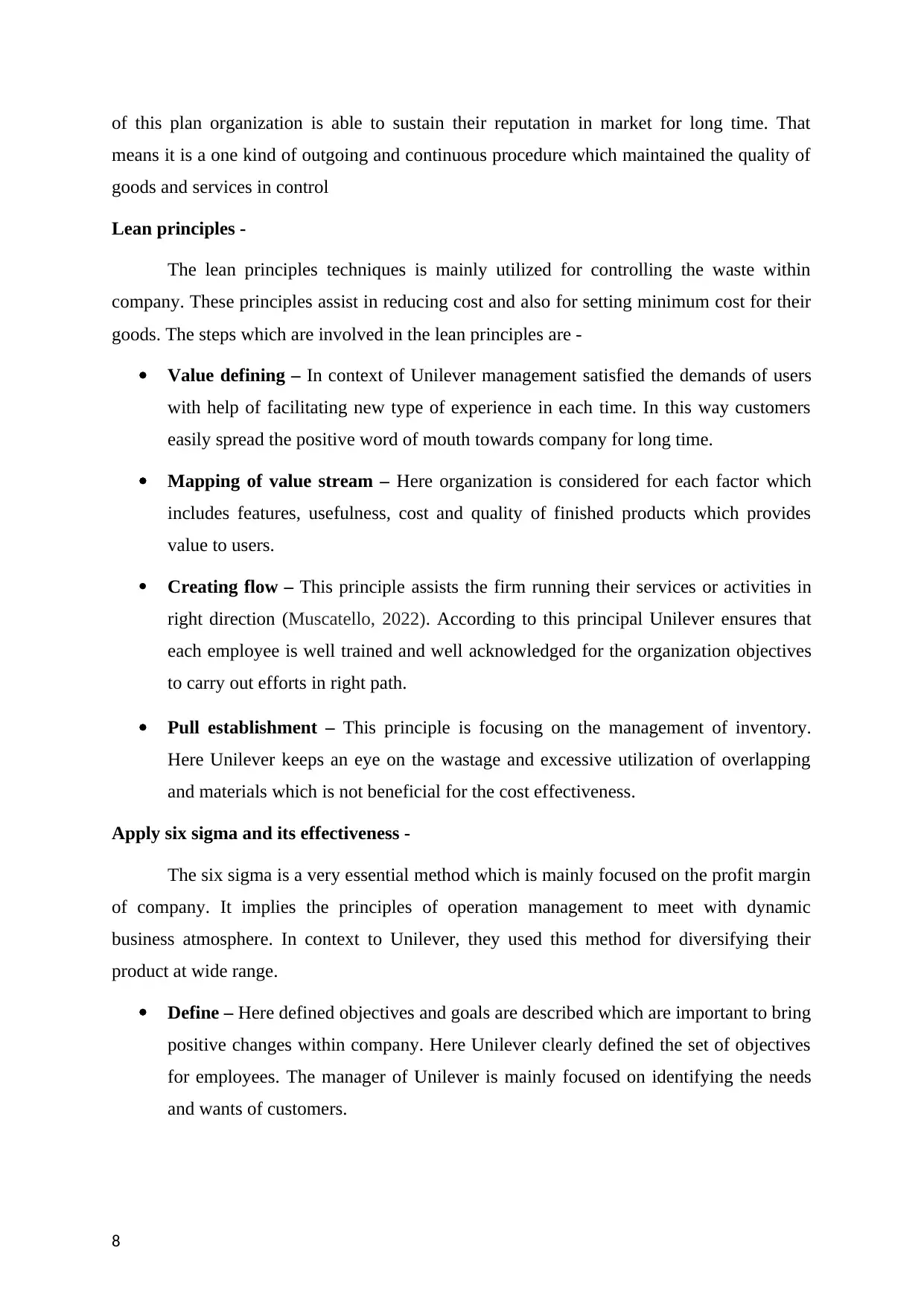
of this plan organization is able to sustain their reputation in market for long time. That
means it is a one kind of outgoing and continuous procedure which maintained the quality of
goods and services in control
Lean principles -
The lean principles techniques is mainly utilized for controlling the waste within
company. These principles assist in reducing cost and also for setting minimum cost for their
goods. The steps which are involved in the lean principles are -
Value defining – In context of Unilever management satisfied the demands of users
with help of facilitating new type of experience in each time. In this way customers
easily spread the positive word of mouth towards company for long time.
Mapping of value stream – Here organization is considered for each factor which
includes features, usefulness, cost and quality of finished products which provides
value to users.
Creating flow – This principle assists the firm running their services or activities in
right direction (Muscatello, 2022). According to this principal Unilever ensures that
each employee is well trained and well acknowledged for the organization objectives
to carry out efforts in right path.
Pull establishment – This principle is focusing on the management of inventory.
Here Unilever keeps an eye on the wastage and excessive utilization of overlapping
and materials which is not beneficial for the cost effectiveness.
Apply six sigma and its effectiveness -
The six sigma is a very essential method which is mainly focused on the profit margin
of company. It implies the principles of operation management to meet with dynamic
business atmosphere. In context to Unilever, they used this method for diversifying their
product at wide range.
Define – Here defined objectives and goals are described which are important to bring
positive changes within company. Here Unilever clearly defined the set of objectives
for employees. The manager of Unilever is mainly focused on identifying the needs
and wants of customers.
8
means it is a one kind of outgoing and continuous procedure which maintained the quality of
goods and services in control
Lean principles -
The lean principles techniques is mainly utilized for controlling the waste within
company. These principles assist in reducing cost and also for setting minimum cost for their
goods. The steps which are involved in the lean principles are -
Value defining – In context of Unilever management satisfied the demands of users
with help of facilitating new type of experience in each time. In this way customers
easily spread the positive word of mouth towards company for long time.
Mapping of value stream – Here organization is considered for each factor which
includes features, usefulness, cost and quality of finished products which provides
value to users.
Creating flow – This principle assists the firm running their services or activities in
right direction (Muscatello, 2022). According to this principal Unilever ensures that
each employee is well trained and well acknowledged for the organization objectives
to carry out efforts in right path.
Pull establishment – This principle is focusing on the management of inventory.
Here Unilever keeps an eye on the wastage and excessive utilization of overlapping
and materials which is not beneficial for the cost effectiveness.
Apply six sigma and its effectiveness -
The six sigma is a very essential method which is mainly focused on the profit margin
of company. It implies the principles of operation management to meet with dynamic
business atmosphere. In context to Unilever, they used this method for diversifying their
product at wide range.
Define – Here defined objectives and goals are described which are important to bring
positive changes within company. Here Unilever clearly defined the set of objectives
for employees. The manager of Unilever is mainly focused on identifying the needs
and wants of customers.
8
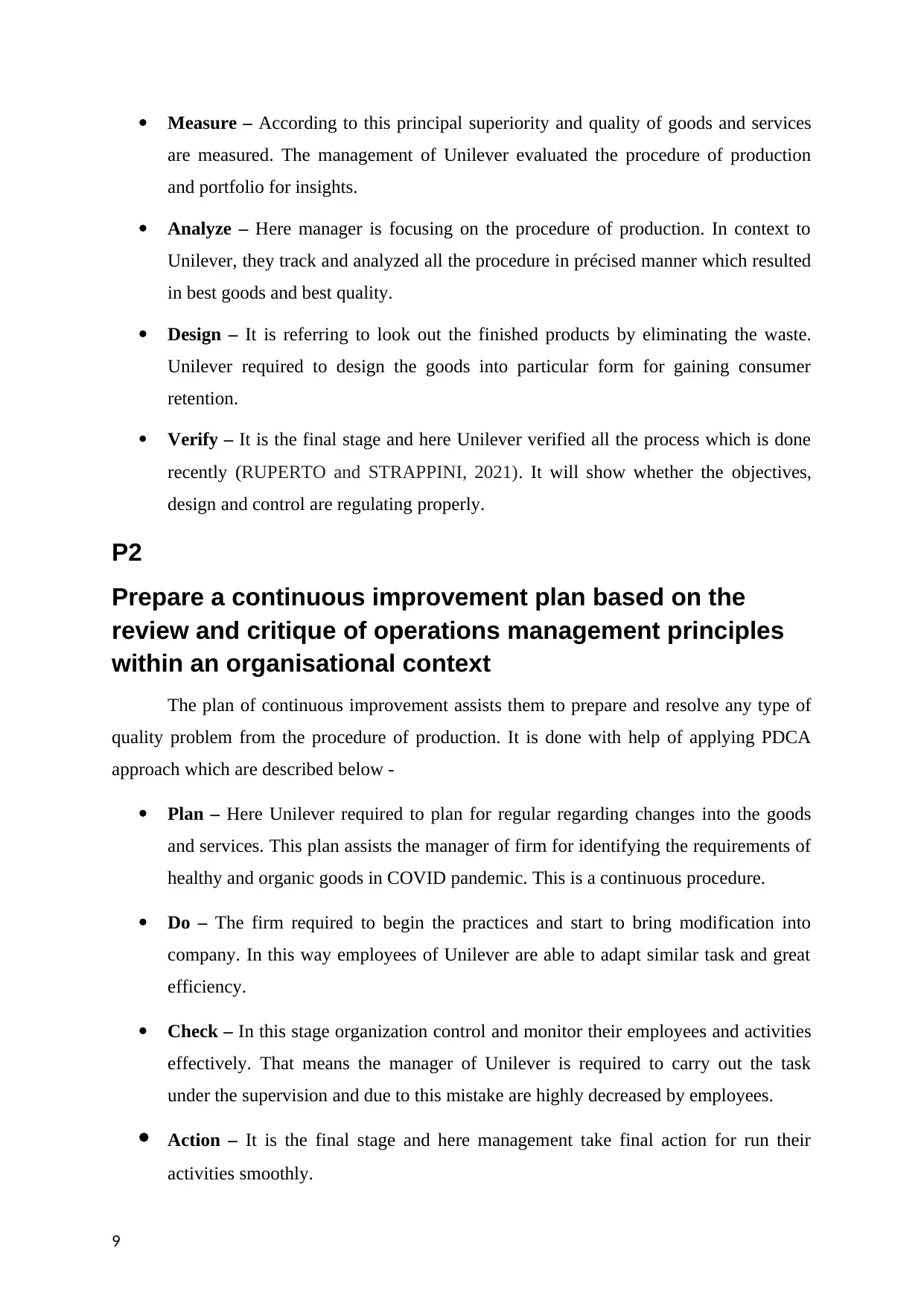
Measure – According to this principal superiority and quality of goods and services
are measured. The management of Unilever evaluated the procedure of production
and portfolio for insights.
Analyze – Here manager is focusing on the procedure of production. In context to
Unilever, they track and analyzed all the procedure in précised manner which resulted
in best goods and best quality.
Design – It is referring to look out the finished products by eliminating the waste.
Unilever required to design the goods into particular form for gaining consumer
retention.
Verify – It is the final stage and here Unilever verified all the process which is done
recently (RUPERTO and STRAPPINI, 2021). It will show whether the objectives,
design and control are regulating properly.
P2
Prepare a continuous improvement plan based on the
review and critique of operations management principles
within an organisational context
The plan of continuous improvement assists them to prepare and resolve any type of
quality problem from the procedure of production. It is done with help of applying PDCA
approach which are described below -
Plan – Here Unilever required to plan for regular regarding changes into the goods
and services. This plan assists the manager of firm for identifying the requirements of
healthy and organic goods in COVID pandemic. This is a continuous procedure.
Do – The firm required to begin the practices and start to bring modification into
company. In this way employees of Unilever are able to adapt similar task and great
efficiency.
Check – In this stage organization control and monitor their employees and activities
effectively. That means the manager of Unilever is required to carry out the task
under the supervision and due to this mistake are highly decreased by employees.
Action – It is the final stage and here management take final action for run their
activities smoothly.
9
are measured. The management of Unilever evaluated the procedure of production
and portfolio for insights.
Analyze – Here manager is focusing on the procedure of production. In context to
Unilever, they track and analyzed all the procedure in précised manner which resulted
in best goods and best quality.
Design – It is referring to look out the finished products by eliminating the waste.
Unilever required to design the goods into particular form for gaining consumer
retention.
Verify – It is the final stage and here Unilever verified all the process which is done
recently (RUPERTO and STRAPPINI, 2021). It will show whether the objectives,
design and control are regulating properly.
P2
Prepare a continuous improvement plan based on the
review and critique of operations management principles
within an organisational context
The plan of continuous improvement assists them to prepare and resolve any type of
quality problem from the procedure of production. It is done with help of applying PDCA
approach which are described below -
Plan – Here Unilever required to plan for regular regarding changes into the goods
and services. This plan assists the manager of firm for identifying the requirements of
healthy and organic goods in COVID pandemic. This is a continuous procedure.
Do – The firm required to begin the practices and start to bring modification into
company. In this way employees of Unilever are able to adapt similar task and great
efficiency.
Check – In this stage organization control and monitor their employees and activities
effectively. That means the manager of Unilever is required to carry out the task
under the supervision and due to this mistake are highly decreased by employees.
Action – It is the final stage and here management take final action for run their
activities smoothly.
9
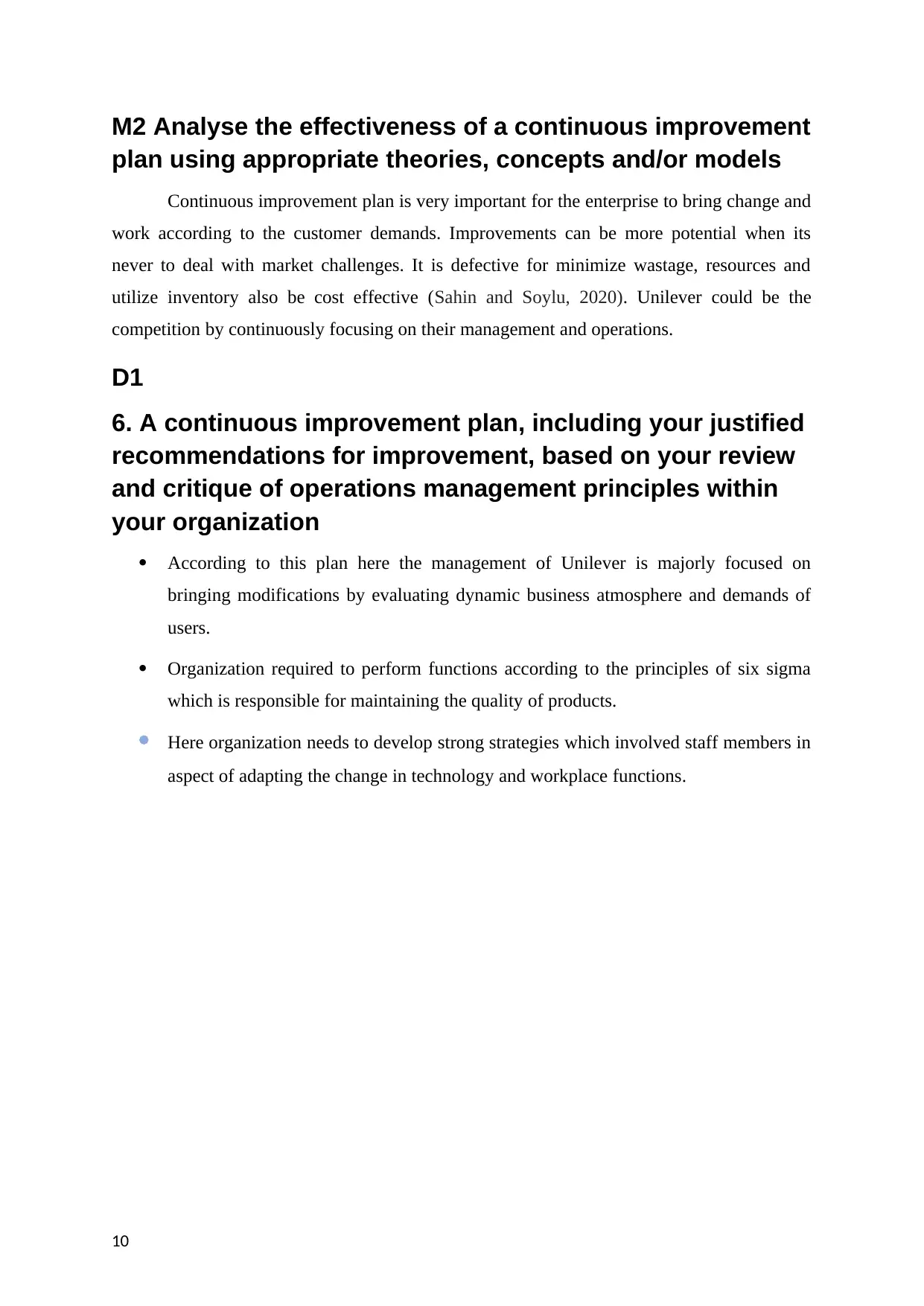
M2 Analyse the effectiveness of a continuous improvement
plan using appropriate theories, concepts and/or models
Continuous improvement plan is very important for the enterprise to bring change and
work according to the customer demands. Improvements can be more potential when its
never to deal with market challenges. It is defective for minimize wastage, resources and
utilize inventory also be cost effective (Sahin and Soylu, 2020). Unilever could be the
competition by continuously focusing on their management and operations.
D1
6. A continuous improvement plan, including your justified
recommendations for improvement, based on your review
and critique of operations management principles within
your organization
According to this plan here the management of Unilever is majorly focused on
bringing modifications by evaluating dynamic business atmosphere and demands of
users.
Organization required to perform functions according to the principles of six sigma
which is responsible for maintaining the quality of products.
Here organization needs to develop strong strategies which involved staff members in
aspect of adapting the change in technology and workplace functions.
10
plan using appropriate theories, concepts and/or models
Continuous improvement plan is very important for the enterprise to bring change and
work according to the customer demands. Improvements can be more potential when its
never to deal with market challenges. It is defective for minimize wastage, resources and
utilize inventory also be cost effective (Sahin and Soylu, 2020). Unilever could be the
competition by continuously focusing on their management and operations.
D1
6. A continuous improvement plan, including your justified
recommendations for improvement, based on your review
and critique of operations management principles within
your organization
According to this plan here the management of Unilever is majorly focused on
bringing modifications by evaluating dynamic business atmosphere and demands of
users.
Organization required to perform functions according to the principles of six sigma
which is responsible for maintaining the quality of products.
Here organization needs to develop strong strategies which involved staff members in
aspect of adapting the change in technology and workplace functions.
10
Secure Best Marks with AI Grader
Need help grading? Try our AI Grader for instant feedback on your assignments.
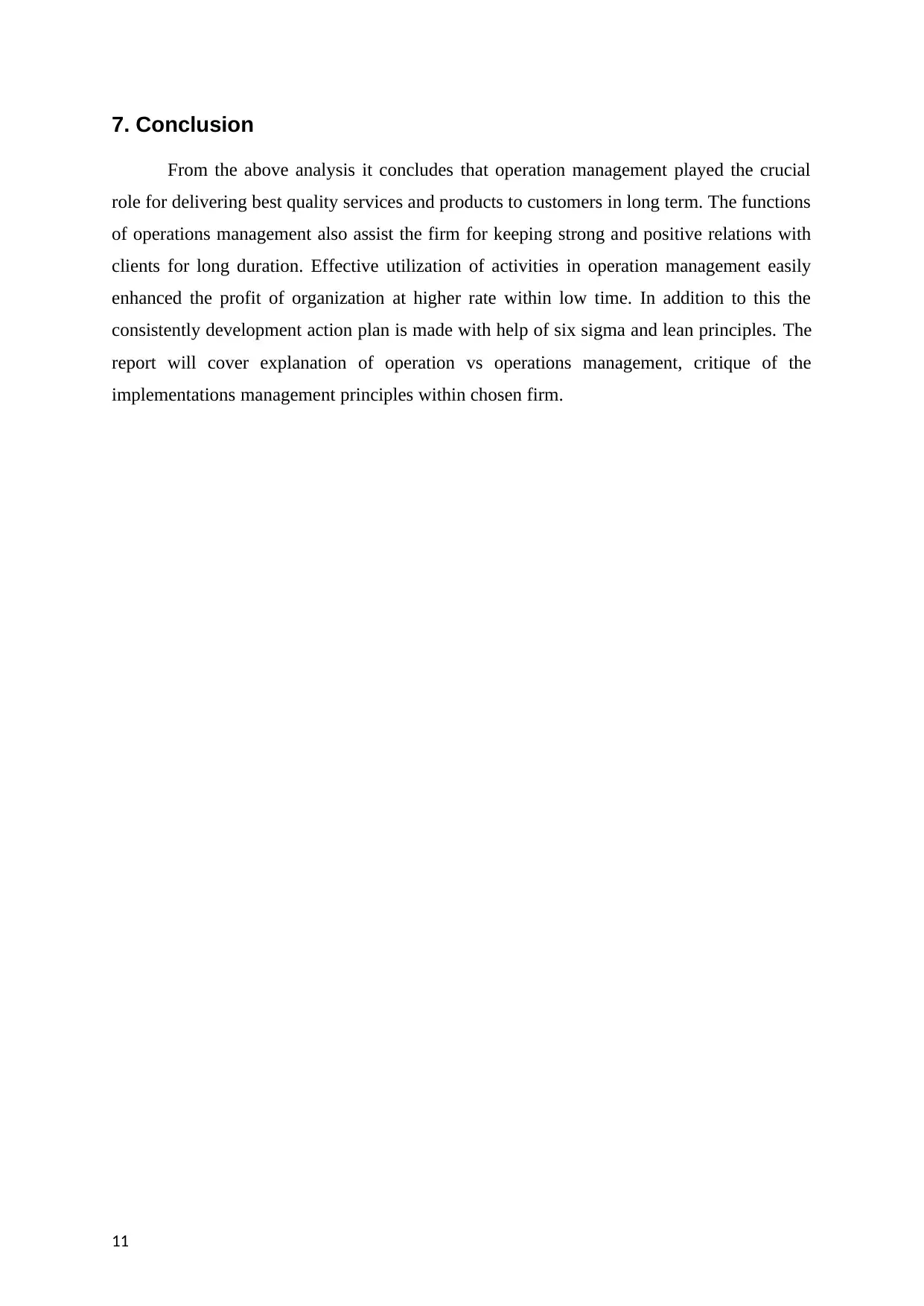
7. Conclusion
From the above analysis it concludes that operation management played the crucial
role for delivering best quality services and products to customers in long term. The functions
of operations management also assist the firm for keeping strong and positive relations with
clients for long duration. Effective utilization of activities in operation management easily
enhanced the profit of organization at higher rate within low time. In addition to this the
consistently development action plan is made with help of six sigma and lean principles. The
report will cover explanation of operation vs operations management, critique of the
implementations management principles within chosen firm.
11
From the above analysis it concludes that operation management played the crucial
role for delivering best quality services and products to customers in long term. The functions
of operations management also assist the firm for keeping strong and positive relations with
clients for long duration. Effective utilization of activities in operation management easily
enhanced the profit of organization at higher rate within low time. In addition to this the
consistently development action plan is made with help of six sigma and lean principles. The
report will cover explanation of operation vs operations management, critique of the
implementations management principles within chosen firm.
11
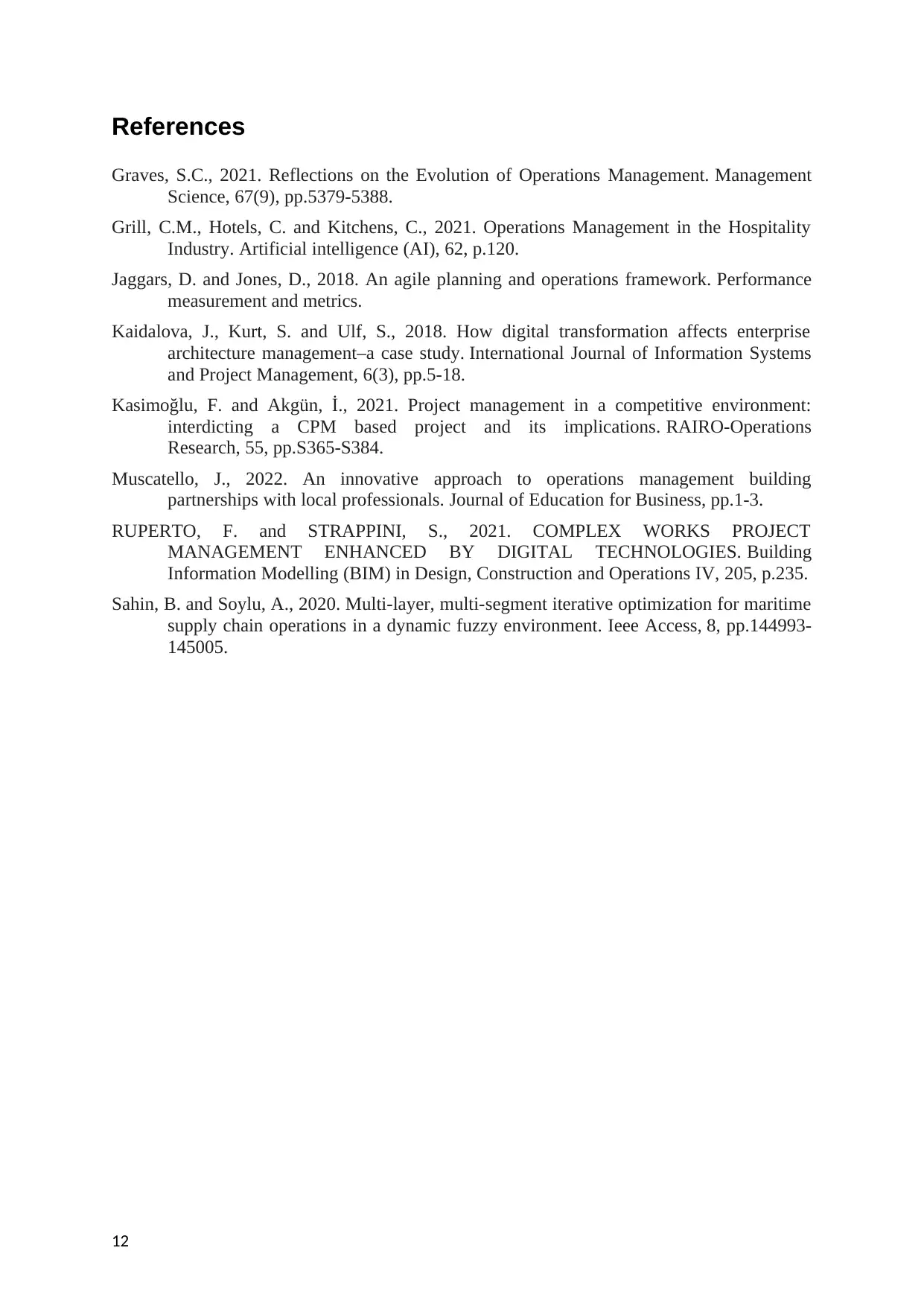
References
Graves, S.C., 2021. Reflections on the Evolution of Operations Management. Management
Science, 67(9), pp.5379-5388.
Grill, C.M., Hotels, C. and Kitchens, C., 2021. Operations Management in the Hospitality
Industry. Artificial intelligence (AI), 62, p.120.
Jaggars, D. and Jones, D., 2018. An agile planning and operations framework. Performance
measurement and metrics.
Kaidalova, J., Kurt, S. and Ulf, S., 2018. How digital transformation affects enterprise
architecture management–a case study. International Journal of Information Systems
and Project Management, 6(3), pp.5-18.
Kasimoğlu, F. and Akgün, İ., 2021. Project management in a competitive environment:
interdicting a CPM based project and its implications. RAIRO-Operations
Research, 55, pp.S365-S384.
Muscatello, J., 2022. An innovative approach to operations management building
partnerships with local professionals. Journal of Education for Business, pp.1-3.
RUPERTO, F. and STRAPPINI, S., 2021. COMPLEX WORKS PROJECT
MANAGEMENT ENHANCED BY DIGITAL TECHNOLOGIES. Building
Information Modelling (BIM) in Design, Construction and Operations IV, 205, p.235.
Sahin, B. and Soylu, A., 2020. Multi-layer, multi-segment iterative optimization for maritime
supply chain operations in a dynamic fuzzy environment. Ieee Access, 8, pp.144993-
145005.
12
Graves, S.C., 2021. Reflections on the Evolution of Operations Management. Management
Science, 67(9), pp.5379-5388.
Grill, C.M., Hotels, C. and Kitchens, C., 2021. Operations Management in the Hospitality
Industry. Artificial intelligence (AI), 62, p.120.
Jaggars, D. and Jones, D., 2018. An agile planning and operations framework. Performance
measurement and metrics.
Kaidalova, J., Kurt, S. and Ulf, S., 2018. How digital transformation affects enterprise
architecture management–a case study. International Journal of Information Systems
and Project Management, 6(3), pp.5-18.
Kasimoğlu, F. and Akgün, İ., 2021. Project management in a competitive environment:
interdicting a CPM based project and its implications. RAIRO-Operations
Research, 55, pp.S365-S384.
Muscatello, J., 2022. An innovative approach to operations management building
partnerships with local professionals. Journal of Education for Business, pp.1-3.
RUPERTO, F. and STRAPPINI, S., 2021. COMPLEX WORKS PROJECT
MANAGEMENT ENHANCED BY DIGITAL TECHNOLOGIES. Building
Information Modelling (BIM) in Design, Construction and Operations IV, 205, p.235.
Sahin, B. and Soylu, A., 2020. Multi-layer, multi-segment iterative optimization for maritime
supply chain operations in a dynamic fuzzy environment. Ieee Access, 8, pp.144993-
145005.
12
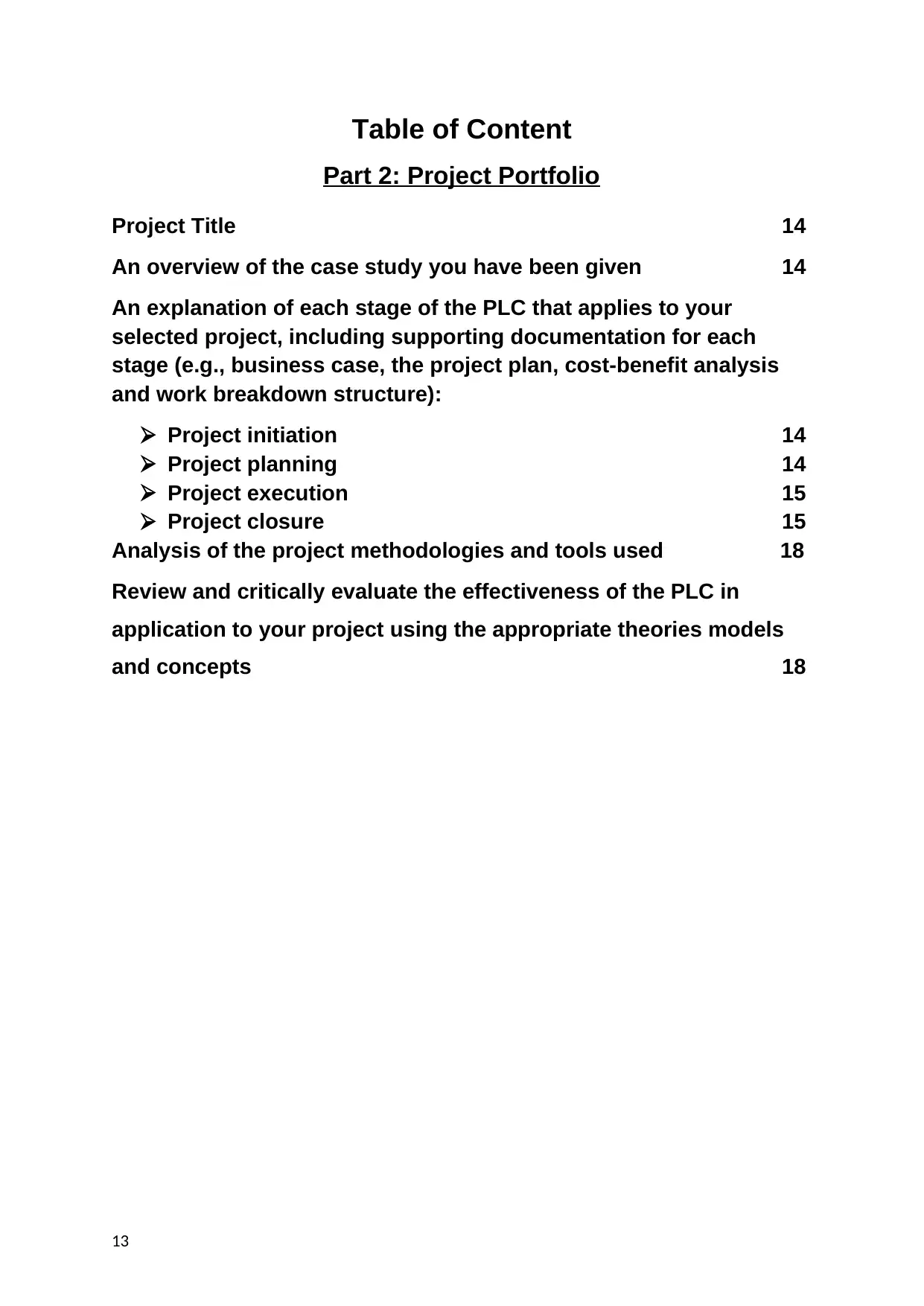
Table of Content
Part 2: Project Portfolio
Project Title 14
An overview of the case study you have been given 14
An explanation of each stage of the PLC that applies to your
selected project, including supporting documentation for each
stage (e.g., business case, the project plan, cost-benefit analysis
and work breakdown structure):
Project initiation 14
Project planning 14
Project execution 15
Project closure 15
Analysis of the project methodologies and tools used 18
Review and critically evaluate the effectiveness of the PLC in
application to your project using the appropriate theories models
and concepts 18
13
Part 2: Project Portfolio
Project Title 14
An overview of the case study you have been given 14
An explanation of each stage of the PLC that applies to your
selected project, including supporting documentation for each
stage (e.g., business case, the project plan, cost-benefit analysis
and work breakdown structure):
Project initiation 14
Project planning 14
Project execution 15
Project closure 15
Analysis of the project methodologies and tools used 18
Review and critically evaluate the effectiveness of the PLC in
application to your project using the appropriate theories models
and concepts 18
13
Paraphrase This Document
Need a fresh take? Get an instant paraphrase of this document with our AI Paraphraser
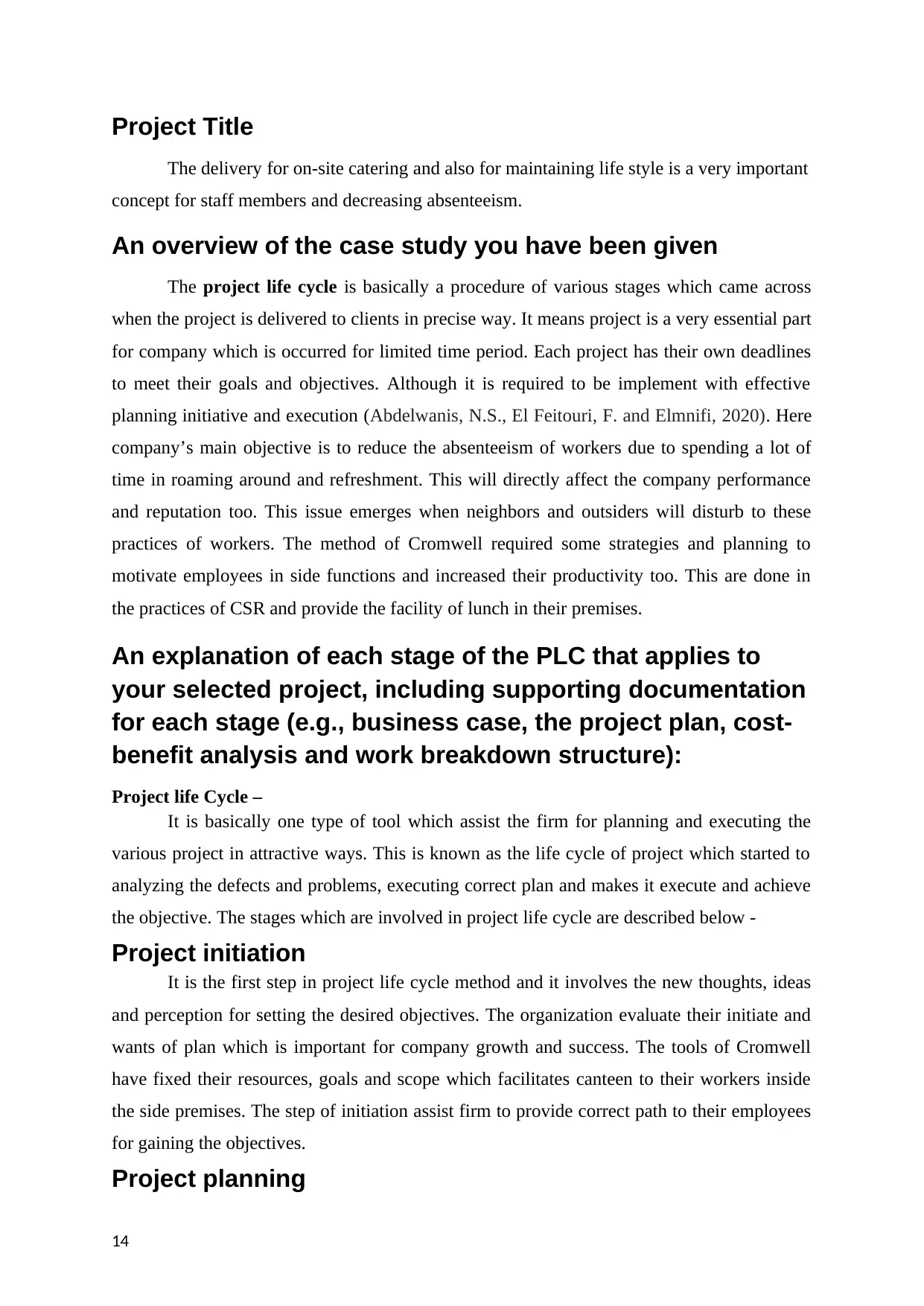
Project Title
The delivery for on-site catering and also for maintaining life style is a very important
concept for staff members and decreasing absenteeism.
An overview of the case study you have been given
The project life cycle is basically a procedure of various stages which came across
when the project is delivered to clients in precise way. It means project is a very essential part
for company which is occurred for limited time period. Each project has their own deadlines
to meet their goals and objectives. Although it is required to be implement with effective
planning initiative and execution (Abdelwanis, N.S., El Feitouri, F. and Elmnifi, 2020). Here
company’s main objective is to reduce the absenteeism of workers due to spending a lot of
time in roaming around and refreshment. This will directly affect the company performance
and reputation too. This issue emerges when neighbors and outsiders will disturb to these
practices of workers. The method of Cromwell required some strategies and planning to
motivate employees in side functions and increased their productivity too. This are done in
the practices of CSR and provide the facility of lunch in their premises.
An explanation of each stage of the PLC that applies to
your selected project, including supporting documentation
for each stage (e.g., business case, the project plan, cost-
benefit analysis and work breakdown structure):
Project life Cycle –
It is basically one type of tool which assist the firm for planning and executing the
various project in attractive ways. This is known as the life cycle of project which started to
analyzing the defects and problems, executing correct plan and makes it execute and achieve
the objective. The stages which are involved in project life cycle are described below -
Project initiation
It is the first step in project life cycle method and it involves the new thoughts, ideas
and perception for setting the desired objectives. The organization evaluate their initiate and
wants of plan which is important for company growth and success. The tools of Cromwell
have fixed their resources, goals and scope which facilitates canteen to their workers inside
the side premises. The step of initiation assist firm to provide correct path to their employees
for gaining the objectives.
Project planning
14
The delivery for on-site catering and also for maintaining life style is a very important
concept for staff members and decreasing absenteeism.
An overview of the case study you have been given
The project life cycle is basically a procedure of various stages which came across
when the project is delivered to clients in precise way. It means project is a very essential part
for company which is occurred for limited time period. Each project has their own deadlines
to meet their goals and objectives. Although it is required to be implement with effective
planning initiative and execution (Abdelwanis, N.S., El Feitouri, F. and Elmnifi, 2020). Here
company’s main objective is to reduce the absenteeism of workers due to spending a lot of
time in roaming around and refreshment. This will directly affect the company performance
and reputation too. This issue emerges when neighbors and outsiders will disturb to these
practices of workers. The method of Cromwell required some strategies and planning to
motivate employees in side functions and increased their productivity too. This are done in
the practices of CSR and provide the facility of lunch in their premises.
An explanation of each stage of the PLC that applies to
your selected project, including supporting documentation
for each stage (e.g., business case, the project plan, cost-
benefit analysis and work breakdown structure):
Project life Cycle –
It is basically one type of tool which assist the firm for planning and executing the
various project in attractive ways. This is known as the life cycle of project which started to
analyzing the defects and problems, executing correct plan and makes it execute and achieve
the objective. The stages which are involved in project life cycle are described below -
Project initiation
It is the first step in project life cycle method and it involves the new thoughts, ideas
and perception for setting the desired objectives. The organization evaluate their initiate and
wants of plan which is important for company growth and success. The tools of Cromwell
have fixed their resources, goals and scope which facilitates canteen to their workers inside
the side premises. The step of initiation assist firm to provide correct path to their employees
for gaining the objectives.
Project planning
14
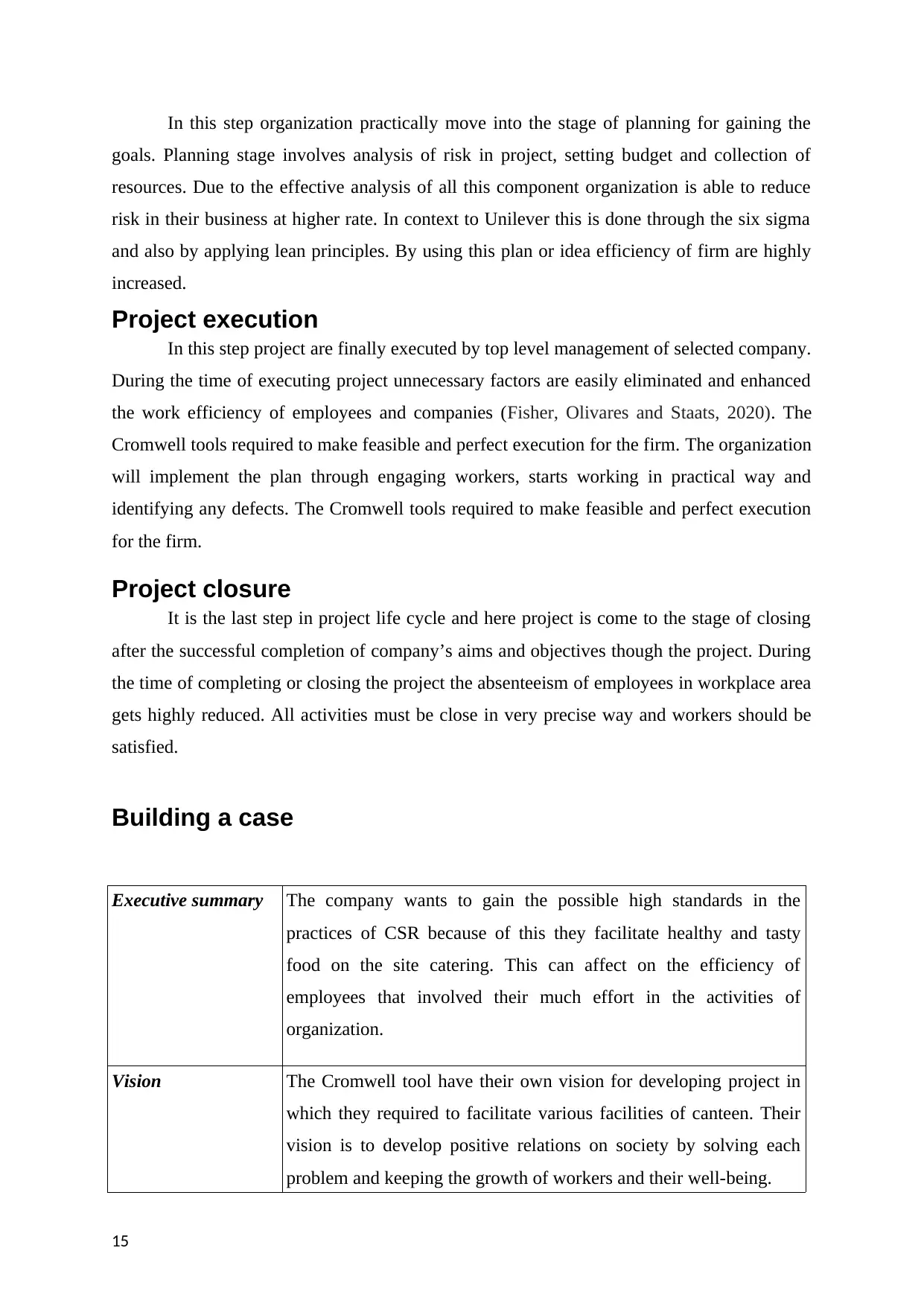
In this step organization practically move into the stage of planning for gaining the
goals. Planning stage involves analysis of risk in project, setting budget and collection of
resources. Due to the effective analysis of all this component organization is able to reduce
risk in their business at higher rate. In context to Unilever this is done through the six sigma
and also by applying lean principles. By using this plan or idea efficiency of firm are highly
increased.
Project execution
In this step project are finally executed by top level management of selected company.
During the time of executing project unnecessary factors are easily eliminated and enhanced
the work efficiency of employees and companies (Fisher, Olivares and Staats, 2020). The
Cromwell tools required to make feasible and perfect execution for the firm. The organization
will implement the plan through engaging workers, starts working in practical way and
identifying any defects. The Cromwell tools required to make feasible and perfect execution
for the firm.
Project closure
It is the last step in project life cycle and here project is come to the stage of closing
after the successful completion of company’s aims and objectives though the project. During
the time of completing or closing the project the absenteeism of employees in workplace area
gets highly reduced. All activities must be close in very precise way and workers should be
satisfied.
Building a case
Executive summary The company wants to gain the possible high standards in the
practices of CSR because of this they facilitate healthy and tasty
food on the site catering. This can affect on the efficiency of
employees that involved their much effort in the activities of
organization.
Vision The Cromwell tool have their own vision for developing project in
which they required to facilitate various facilities of canteen. Their
vision is to develop positive relations on society by solving each
problem and keeping the growth of workers and their well-being.
15
goals. Planning stage involves analysis of risk in project, setting budget and collection of
resources. Due to the effective analysis of all this component organization is able to reduce
risk in their business at higher rate. In context to Unilever this is done through the six sigma
and also by applying lean principles. By using this plan or idea efficiency of firm are highly
increased.
Project execution
In this step project are finally executed by top level management of selected company.
During the time of executing project unnecessary factors are easily eliminated and enhanced
the work efficiency of employees and companies (Fisher, Olivares and Staats, 2020). The
Cromwell tools required to make feasible and perfect execution for the firm. The organization
will implement the plan through engaging workers, starts working in practical way and
identifying any defects. The Cromwell tools required to make feasible and perfect execution
for the firm.
Project closure
It is the last step in project life cycle and here project is come to the stage of closing
after the successful completion of company’s aims and objectives though the project. During
the time of completing or closing the project the absenteeism of employees in workplace area
gets highly reduced. All activities must be close in very precise way and workers should be
satisfied.
Building a case
Executive summary The company wants to gain the possible high standards in the
practices of CSR because of this they facilitate healthy and tasty
food on the site catering. This can affect on the efficiency of
employees that involved their much effort in the activities of
organization.
Vision The Cromwell tool have their own vision for developing project in
which they required to facilitate various facilities of canteen. Their
vision is to develop positive relations on society by solving each
problem and keeping the growth of workers and their well-being.
15
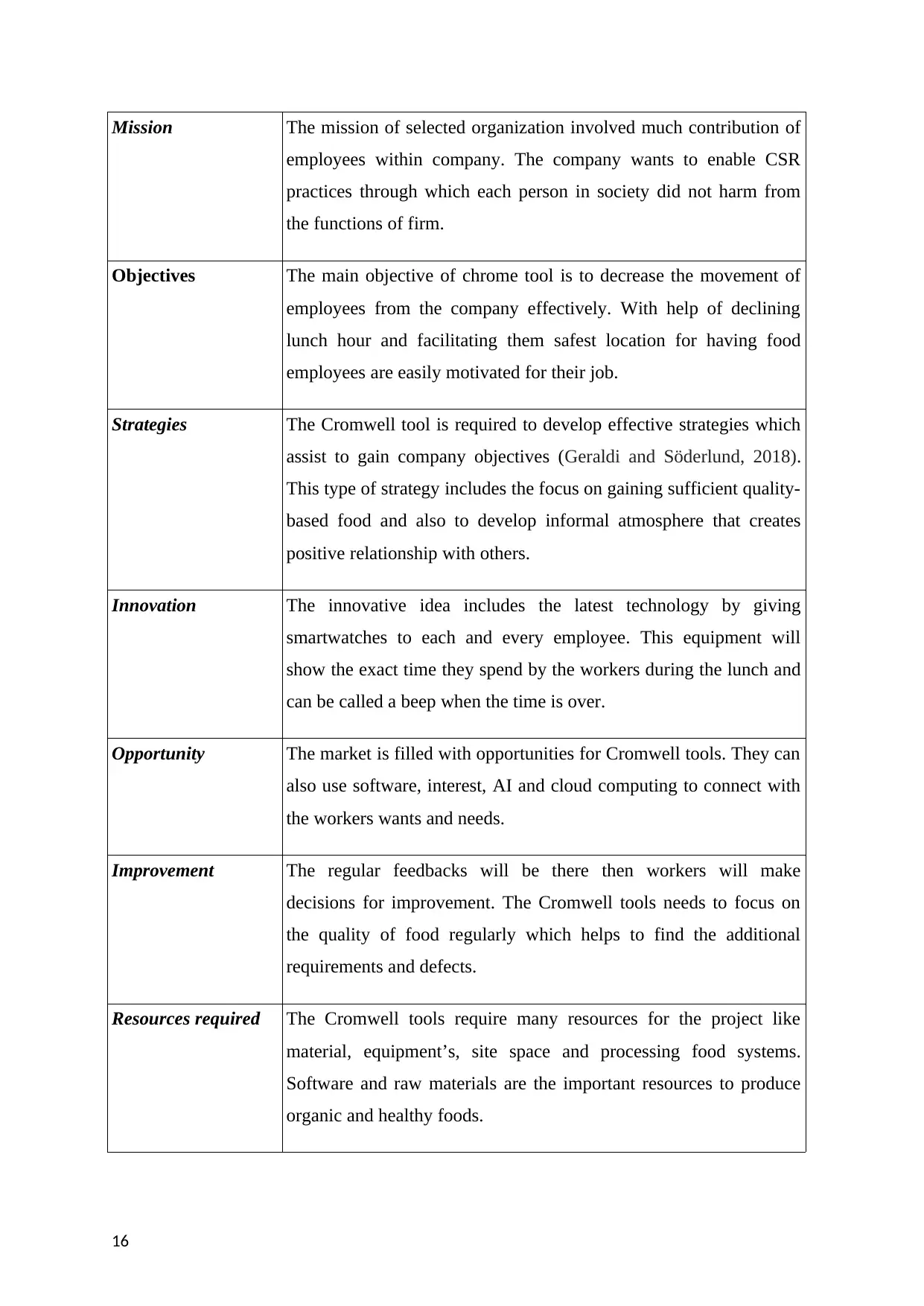
Mission The mission of selected organization involved much contribution of
employees within company. The company wants to enable CSR
practices through which each person in society did not harm from
the functions of firm.
Objectives The main objective of chrome tool is to decrease the movement of
employees from the company effectively. With help of declining
lunch hour and facilitating them safest location for having food
employees are easily motivated for their job.
Strategies The Cromwell tool is required to develop effective strategies which
assist to gain company objectives (Geraldi and Söderlund, 2018).
This type of strategy includes the focus on gaining sufficient quality-
based food and also to develop informal atmosphere that creates
positive relationship with others.
Innovation The innovative idea includes the latest technology by giving
smartwatches to each and every employee. This equipment will
show the exact time they spend by the workers during the lunch and
can be called a beep when the time is over.
Opportunity The market is filled with opportunities for Cromwell tools. They can
also use software, interest, AI and cloud computing to connect with
the workers wants and needs.
Improvement The regular feedbacks will be there then workers will make
decisions for improvement. The Cromwell tools needs to focus on
the quality of food regularly which helps to find the additional
requirements and defects.
Resources required The Cromwell tools require many resources for the project like
material, equipment’s, site space and processing food systems.
Software and raw materials are the important resources to produce
organic and healthy foods.
16
employees within company. The company wants to enable CSR
practices through which each person in society did not harm from
the functions of firm.
Objectives The main objective of chrome tool is to decrease the movement of
employees from the company effectively. With help of declining
lunch hour and facilitating them safest location for having food
employees are easily motivated for their job.
Strategies The Cromwell tool is required to develop effective strategies which
assist to gain company objectives (Geraldi and Söderlund, 2018).
This type of strategy includes the focus on gaining sufficient quality-
based food and also to develop informal atmosphere that creates
positive relationship with others.
Innovation The innovative idea includes the latest technology by giving
smartwatches to each and every employee. This equipment will
show the exact time they spend by the workers during the lunch and
can be called a beep when the time is over.
Opportunity The market is filled with opportunities for Cromwell tools. They can
also use software, interest, AI and cloud computing to connect with
the workers wants and needs.
Improvement The regular feedbacks will be there then workers will make
decisions for improvement. The Cromwell tools needs to focus on
the quality of food regularly which helps to find the additional
requirements and defects.
Resources required The Cromwell tools require many resources for the project like
material, equipment’s, site space and processing food systems.
Software and raw materials are the important resources to produce
organic and healthy foods.
16
Secure Best Marks with AI Grader
Need help grading? Try our AI Grader for instant feedback on your assignments.
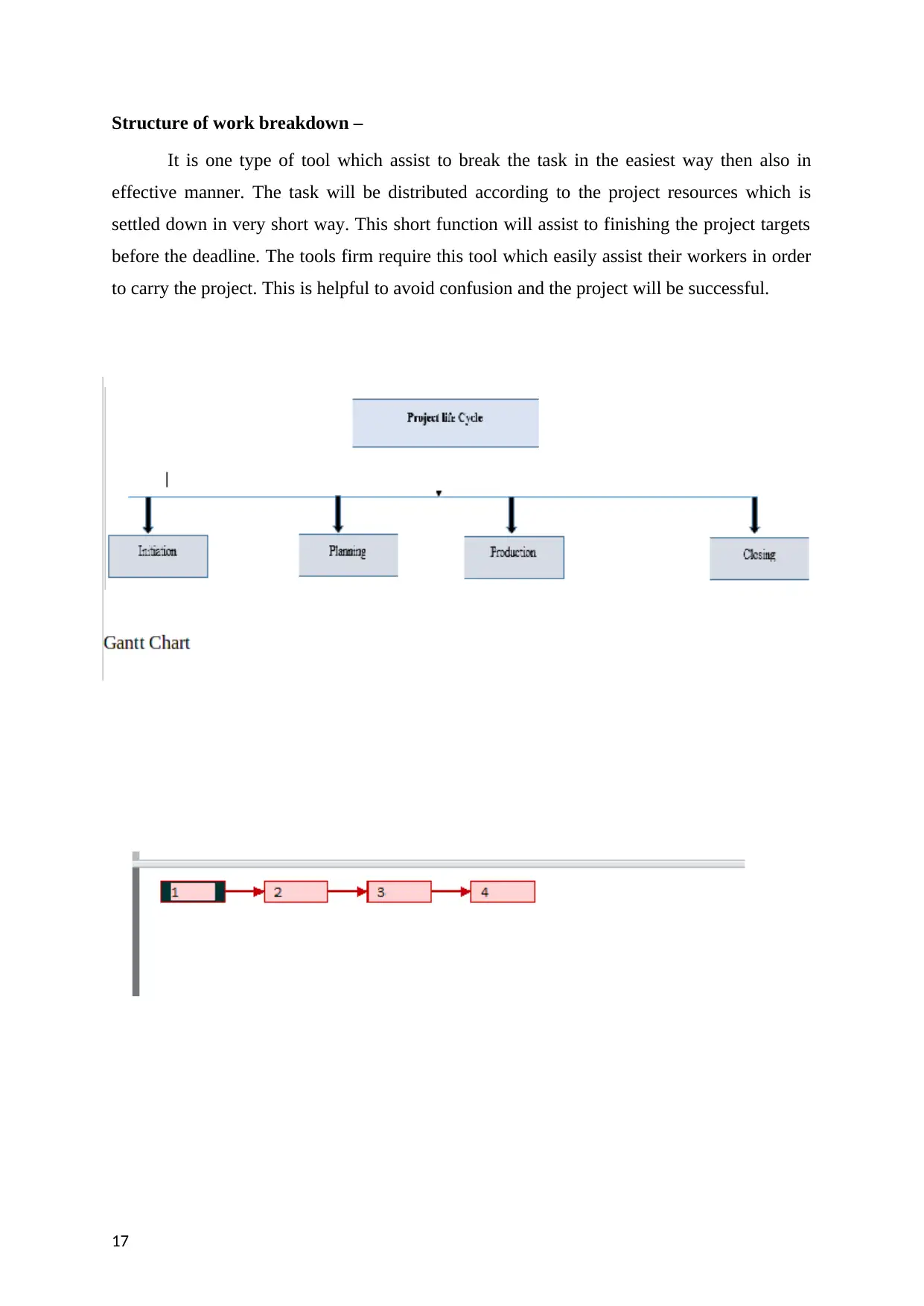
Structure of work breakdown –
It is one type of tool which assist to break the task in the easiest way then also in
effective manner. The task will be distributed according to the project resources which is
settled down in very short way. This short function will assist to finishing the project targets
before the deadline. The tools firm require this tool which easily assist their workers in order
to carry the project. This is helpful to avoid confusion and the project will be successful.
17
It is one type of tool which assist to break the task in the easiest way then also in
effective manner. The task will be distributed according to the project resources which is
settled down in very short way. This short function will assist to finishing the project targets
before the deadline. The tools firm require this tool which easily assist their workers in order
to carry the project. This is helpful to avoid confusion and the project will be successful.
17
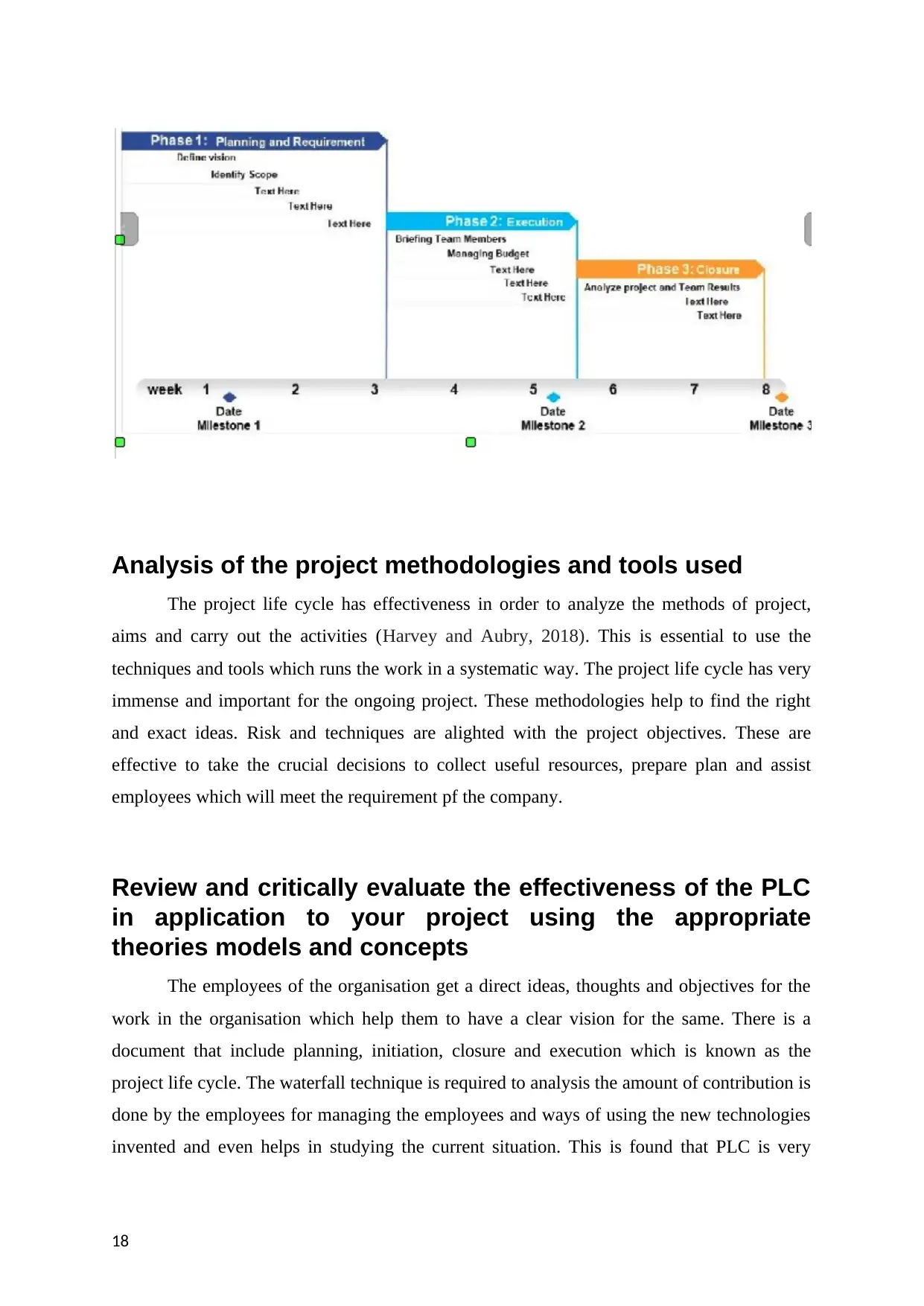
Analysis of the project methodologies and tools used
The project life cycle has effectiveness in order to analyze the methods of project,
aims and carry out the activities (Harvey and Aubry, 2018). This is essential to use the
techniques and tools which runs the work in a systematic way. The project life cycle has very
immense and important for the ongoing project. These methodologies help to find the right
and exact ideas. Risk and techniques are alighted with the project objectives. These are
effective to take the crucial decisions to collect useful resources, prepare plan and assist
employees which will meet the requirement pf the company.
Review and critically evaluate the effectiveness of the PLC
in application to your project using the appropriate
theories models and concepts
The employees of the organisation get a direct ideas, thoughts and objectives for the
work in the organisation which help them to have a clear vision for the same. There is a
document that include planning, initiation, closure and execution which is known as the
project life cycle. The waterfall technique is required to analysis the amount of contribution is
done by the employees for managing the employees and ways of using the new technologies
invented and even helps in studying the current situation. This is found that PLC is very
18
The project life cycle has effectiveness in order to analyze the methods of project,
aims and carry out the activities (Harvey and Aubry, 2018). This is essential to use the
techniques and tools which runs the work in a systematic way. The project life cycle has very
immense and important for the ongoing project. These methodologies help to find the right
and exact ideas. Risk and techniques are alighted with the project objectives. These are
effective to take the crucial decisions to collect useful resources, prepare plan and assist
employees which will meet the requirement pf the company.
Review and critically evaluate the effectiveness of the PLC
in application to your project using the appropriate
theories models and concepts
The employees of the organisation get a direct ideas, thoughts and objectives for the
work in the organisation which help them to have a clear vision for the same. There is a
document that include planning, initiation, closure and execution which is known as the
project life cycle. The waterfall technique is required to analysis the amount of contribution is
done by the employees for managing the employees and ways of using the new technologies
invented and even helps in studying the current situation. This is found that PLC is very
18
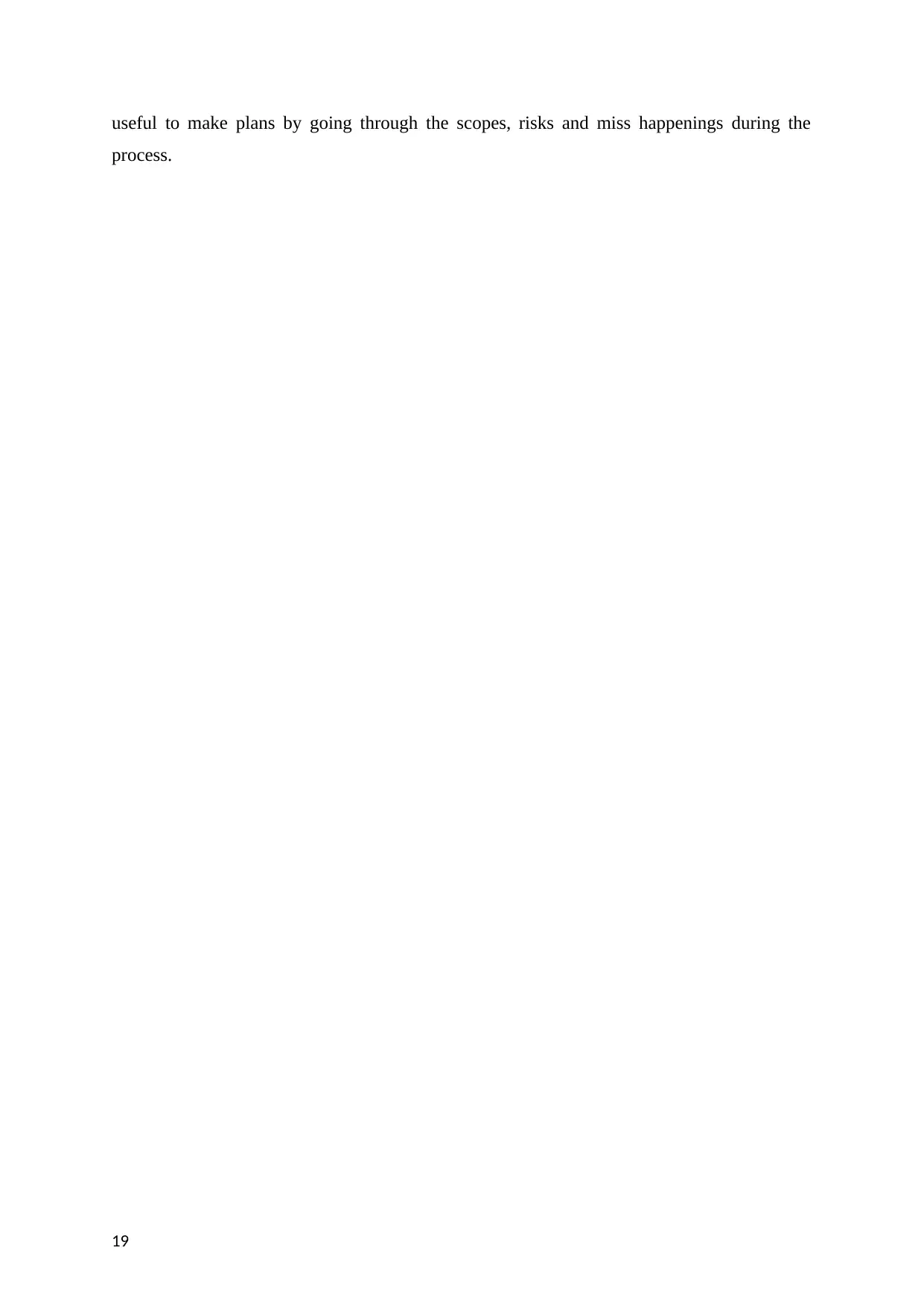
useful to make plans by going through the scopes, risks and miss happenings during the
process.
19
process.
19
Paraphrase This Document
Need a fresh take? Get an instant paraphrase of this document with our AI Paraphraser
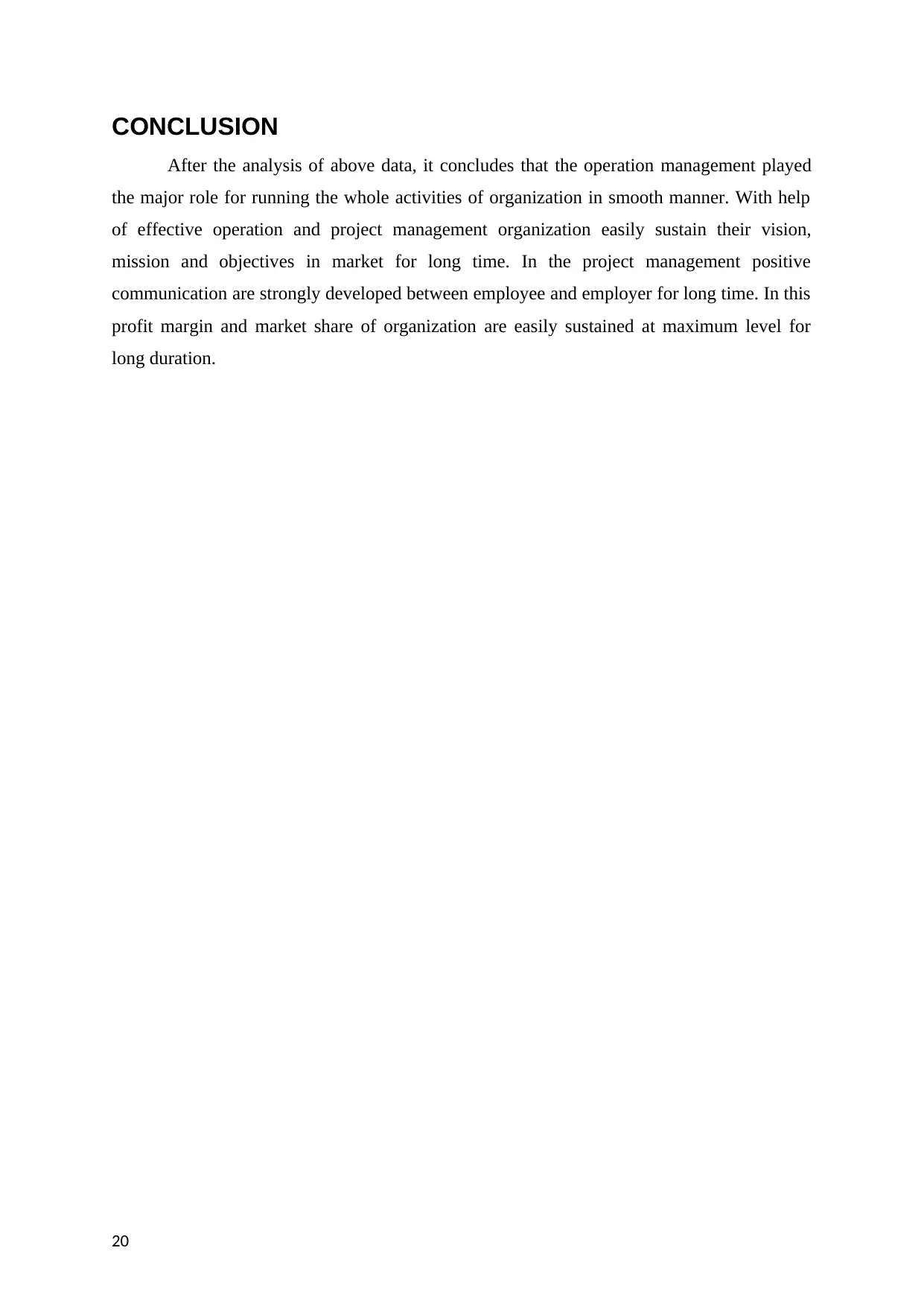
CONCLUSION
After the analysis of above data, it concludes that the operation management played
the major role for running the whole activities of organization in smooth manner. With help
of effective operation and project management organization easily sustain their vision,
mission and objectives in market for long time. In the project management positive
communication are strongly developed between employee and employer for long time. In this
profit margin and market share of organization are easily sustained at maximum level for
long duration.
20
After the analysis of above data, it concludes that the operation management played
the major role for running the whole activities of organization in smooth manner. With help
of effective operation and project management organization easily sustain their vision,
mission and objectives in market for long time. In the project management positive
communication are strongly developed between employee and employer for long time. In this
profit margin and market share of organization are easily sustained at maximum level for
long duration.
20
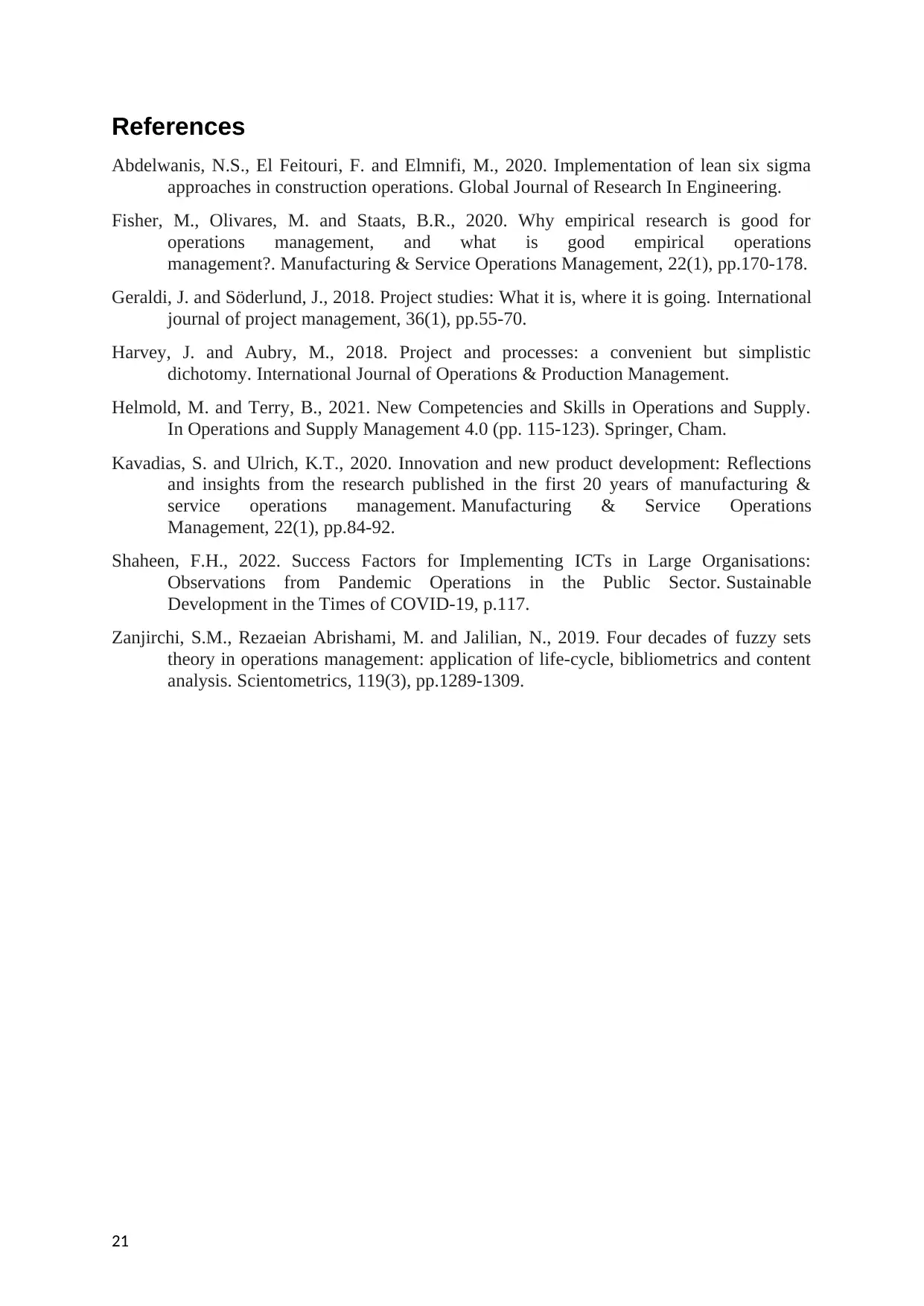
References
Abdelwanis, N.S., El Feitouri, F. and Elmnifi, M., 2020. Implementation of lean six sigma
approaches in construction operations. Global Journal of Research In Engineering.
Fisher, M., Olivares, M. and Staats, B.R., 2020. Why empirical research is good for
operations management, and what is good empirical operations
management?. Manufacturing & Service Operations Management, 22(1), pp.170-178.
Geraldi, J. and Söderlund, J., 2018. Project studies: What it is, where it is going. International
journal of project management, 36(1), pp.55-70.
Harvey, J. and Aubry, M., 2018. Project and processes: a convenient but simplistic
dichotomy. International Journal of Operations & Production Management.
Helmold, M. and Terry, B., 2021. New Competencies and Skills in Operations and Supply.
In Operations and Supply Management 4.0 (pp. 115-123). Springer, Cham.
Kavadias, S. and Ulrich, K.T., 2020. Innovation and new product development: Reflections
and insights from the research published in the first 20 years of manufacturing &
service operations management. Manufacturing & Service Operations
Management, 22(1), pp.84-92.
Shaheen, F.H., 2022. Success Factors for Implementing ICTs in Large Organisations:
Observations from Pandemic Operations in the Public Sector. Sustainable
Development in the Times of COVID-19, p.117.
Zanjirchi, S.M., Rezaeian Abrishami, M. and Jalilian, N., 2019. Four decades of fuzzy sets
theory in operations management: application of life-cycle, bibliometrics and content
analysis. Scientometrics, 119(3), pp.1289-1309.
21
Abdelwanis, N.S., El Feitouri, F. and Elmnifi, M., 2020. Implementation of lean six sigma
approaches in construction operations. Global Journal of Research In Engineering.
Fisher, M., Olivares, M. and Staats, B.R., 2020. Why empirical research is good for
operations management, and what is good empirical operations
management?. Manufacturing & Service Operations Management, 22(1), pp.170-178.
Geraldi, J. and Söderlund, J., 2018. Project studies: What it is, where it is going. International
journal of project management, 36(1), pp.55-70.
Harvey, J. and Aubry, M., 2018. Project and processes: a convenient but simplistic
dichotomy. International Journal of Operations & Production Management.
Helmold, M. and Terry, B., 2021. New Competencies and Skills in Operations and Supply.
In Operations and Supply Management 4.0 (pp. 115-123). Springer, Cham.
Kavadias, S. and Ulrich, K.T., 2020. Innovation and new product development: Reflections
and insights from the research published in the first 20 years of manufacturing &
service operations management. Manufacturing & Service Operations
Management, 22(1), pp.84-92.
Shaheen, F.H., 2022. Success Factors for Implementing ICTs in Large Organisations:
Observations from Pandemic Operations in the Public Sector. Sustainable
Development in the Times of COVID-19, p.117.
Zanjirchi, S.M., Rezaeian Abrishami, M. and Jalilian, N., 2019. Four decades of fuzzy sets
theory in operations management: application of life-cycle, bibliometrics and content
analysis. Scientometrics, 119(3), pp.1289-1309.
21

22
1 out of 22
Related Documents
Your All-in-One AI-Powered Toolkit for Academic Success.
+13062052269
info@desklib.com
Available 24*7 on WhatsApp / Email
![[object Object]](/_next/static/media/star-bottom.7253800d.svg)
Unlock your academic potential
© 2024 | Zucol Services PVT LTD | All rights reserved.



